ELT (Extremely Large Telescope)
Astronomy and Telescopes
ELT (Extremely Large Telescope)
European Extremely Large Telescope Development Status Sensor Complement References
Extremely large telescopes are considered worldwide to be one of the highest priorities in ground-based astronomy. They will vastly advance astrophysical knowledge, allowing detailed studies of subjects including planets around other stars, the first objects in the Universe, supermassive black holes, and the nature and distribution of the dark matter and dark energy which dominate the Universe. 1) 2)
Since 2005 ESO has been working with its community and industry to develop an extremely large optical/infrared telescope. Named the ELT (Extremely Large Telescope), this revolutionary new ground-based telescope concept will have a 39 meter main mirror and will be the largest optical/near-infrared telescope in the world: "the world's biggest eye on the sky". In addition to this unparalleled size, the ELT will be equipped with a lineup of cutting-edge instruments, designed to cover a wide range of scientific possibilities. The leap forwards with the ELT can lead to a paradigm shift in our perception of the Universe, much as Galileo's telescope did 400 years ago.
Preparing a Revolution
Astronomy is experiencing a golden era. The past decades have brought amazing discoveries that have excited people from all walks of life, from finding planets around Proxima Centauri, the nearest star to the Sun, to the first image of a black hole.
Europe is at the forefront of all areas of contemporary astronomy, thanks in particular to the flagship groundbased facilities operated by ESO, the preeminent intergovernmental science and technology organization in astronomy. The challenge is to consolidate and strengthen this position for the future. This will be achieved with a revolutionary new groundbased telescope, the European Extremely Large Telescope (EELT), with a performance that is orders of magnitude better than currently existing facilities.
The ELT is a novel ground-based telescope concept with a performance that is orders of magnitude better than currently existing facilities. Equipped with the most advanced instruments, such a telescope may, eventually, revolutionize our perception of the Universe, much as Galileo's telescope did 400 years ago.
The ELT program was approved in 2012 and green light for construction at Cerro Armazones was given at the end of 2014. The first stone ceremony for the telescope was attended by the President of Chile in May 2017. Dozens of Europe's most cutting-edge companies are participating in the construction. First light is targeted for 2025.
An Expanded View of the Universe — Science with the European Extremely Large Telescope
The year 2009 was celebrated by the International Astronomical Union and UNESCO as the International Year of Astronomy. It marked the passing of 400 years since Galileo Galilei first used a telescope for astronomical research, making the ground-breaking observations that would finally refute the geocentric Ptolemaic worldview and establish the heliocentric Copernican one. In the same year, Johannes Kepler published his Astronomia Nova, in which he introduced his laws of planetary motion for the Solar System. The year 1609 signalled a true revolution in astronomy. 3)
Since then, astronomical observations with telescopes have increasingly become the norm, until today, when institutes around the world host giant telescopes that work every available second to collect immense quantities of data. Each technological advance has brought new, and often totally unexpected, discoveries about our Universe, enriching our cultural heritage.
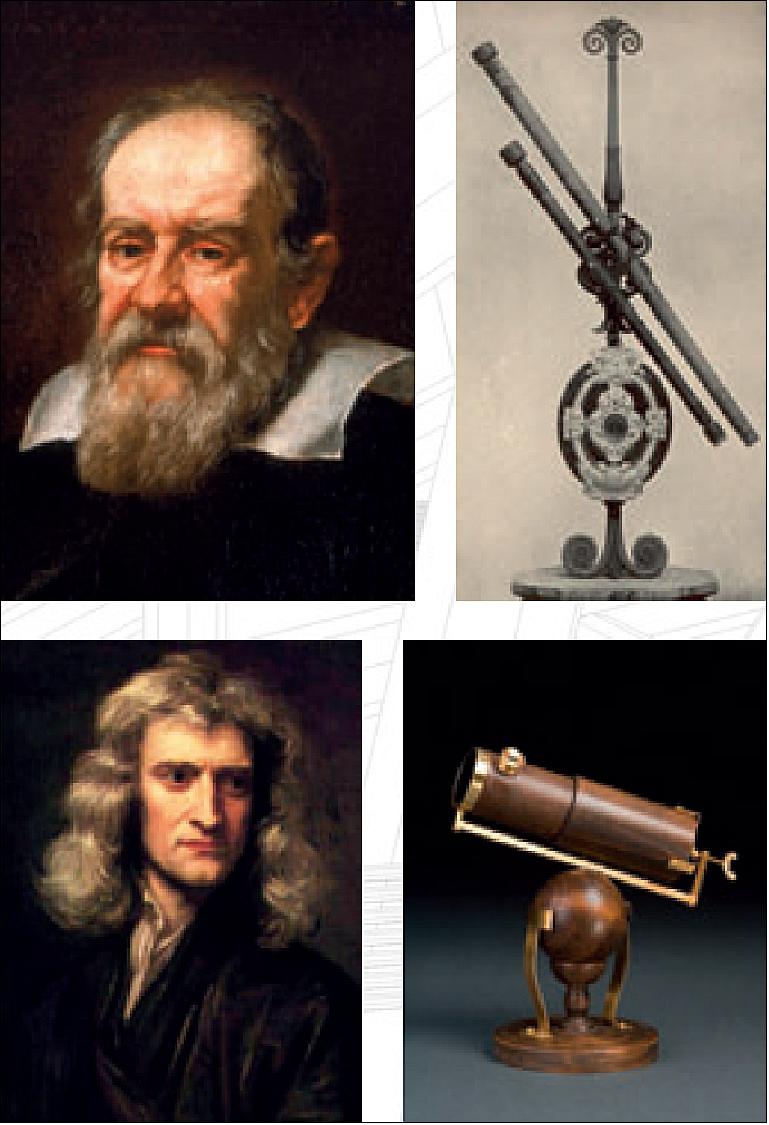
Ever Larger Telescopes
In 1669, a few decades after the invention of the refracting telescope, a design based on lenses, Isaac Newton introduced the first practical reflecting telescope, using mirrors. Over the following 300 years, these two telescope design concepts competed and evolved into ever more powerful research facilities. For about two centuries, refracting telescopes were in the lead, overcoming image quality problems with smart choices of optical designs and glass combinations. Refractor technology peaked towards the end of the 19th century with the big Lick and Yerkes Refractors, which used lenses of 90 centimeters and one meter in diameter, respectively. However, these lenses and their supports proved to be the largest that could practically be constructed, and thus reflecting telescopes finally won the day.
Reflecting telescopes in the 19th century suffered from the poor reflectivity and thermal properties of their mirrors. Despite this limitation, William Herschel and William Parsons, the third Earl of Rosse, were able to build reflectors with diameters ranging from 1.25 to 1.80 meters around the turn of the 18th century, with which they discovered more planets and moons in the Solar System, expanding the boundaries of the then known Universe further.
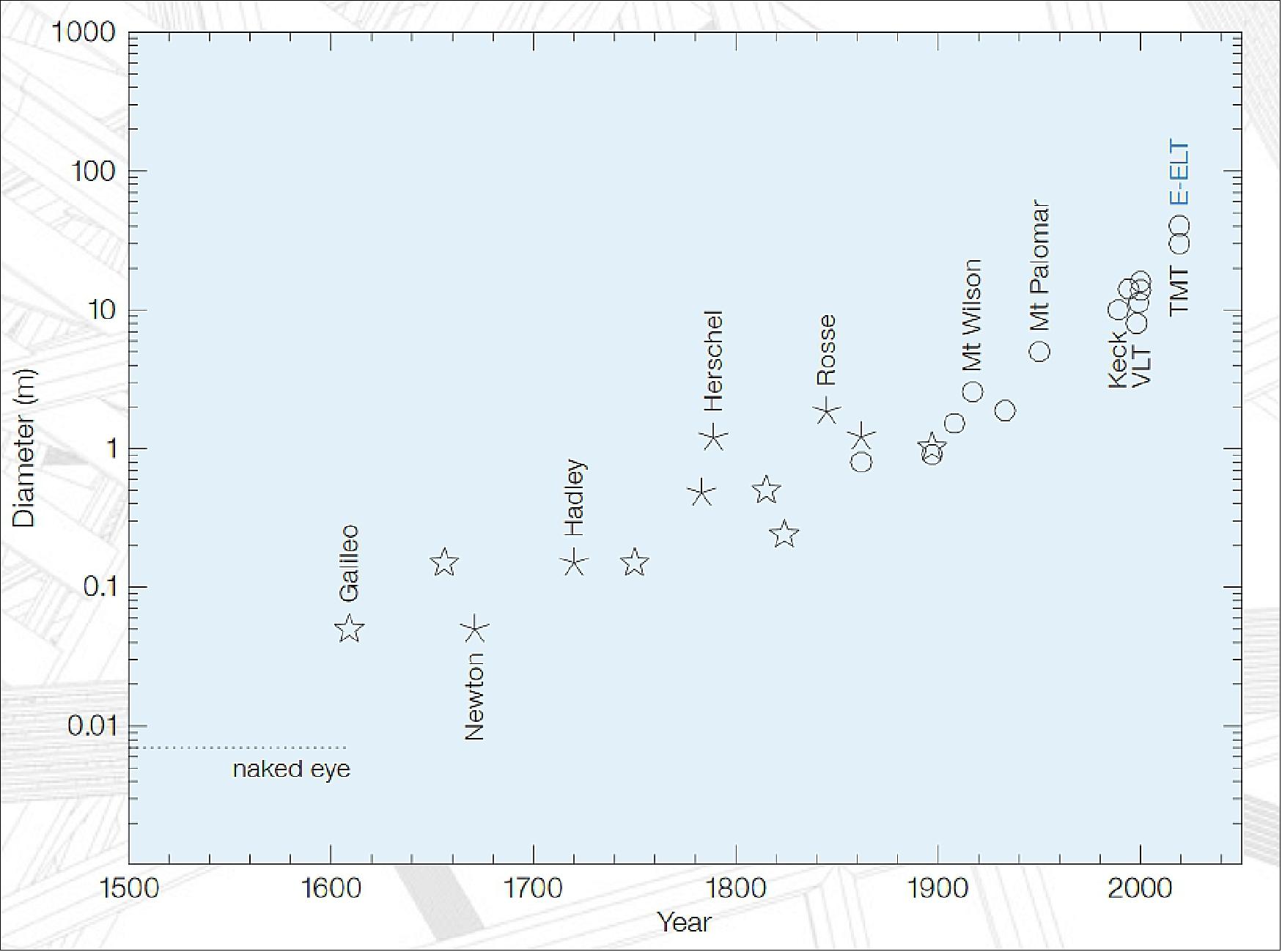
The mirror efficiency problem was only solved in the mid-19th century, when the coating of glass with silver became feasible. This paved the way for the first modern telescopes, such as the Hooker 2.5-meter telescope (1917) and the Hale 5-meter telescope (1948).
With the new giant telescopes also came the next revolution in knowledge: the Sun, the most prominent object in the sky, was downgraded to a mere dwarf star; the Milky Way was demonstrated to be only one galaxy among millions, and the Universe, assumed to be static and eternal, was found to be expanding and to have a finite age! By the middle of the 20th century, our worldview had little in common with the one preceding the invention of the telescope.
Progress has since continued. Telescopes also expand the observable wavelength domain. Over the last sixty years, astronomers have developed telescopes that are able to observe right across the electromagnetic spectrum. Antennas for low frequency — radio, millimeter and submillimeter — observations were constructed, allowing many scientific breakthroughs, such as the discoveries of quasars, pulsars, the cosmic microwave background, and much more.
Further, space observatories have allowed observations to be pushed to shorter wavelengths, into the ultraviolet, X-ray and gamma-ray regimes. This opening up of the high energy frontier generated a further flood of discoveries such as X-ray stars, gamma-ray bursts, black hole accretion discs, and other exotic phenomena. Previously unknown physical processes were taking place in the Universe around us. These discoveries led to a number of Nobel Prizes in Physics (in 1974, 1978, 1993, 2002 and 2006) and to giant leaps in our understanding of the cosmos.
While astronomy has expanded out into these new wavelength bands, many discoveries are still being made in the visible and near-infrared regimes, where stars predominantly emit their light. Technological advances in the 1980s and 1990s allowed scientists to build ever larger telescopes and ever more sensitive cameras. These instruments have opened up whole new areas of study. For example, the first exoplanets (planets orbiting other stars) were detected, and the current generation of 8–10-meter class telescopes even allowed us to take the first pictures of a few of these objects. Our knowledge in astronomy continues to progress at an incredible pace, answering many questions, but also raising exciting new ones.
The European Extremely Large Telescope (E-ELT) will address these new questions, and in the following sections we seek to give a flavor of the kind of fundamental questions that it will finally answer. However, just as Galileo was astounded to find mountains on the Moon and moons orbiting Jupiter, the most exciting discoveries are probably those that we have not yet even imagined.
The European Extremely Large Telescope
Europe is at the forefront of all areas of contemporary astronomy, thanks, in particular, to the flagship ground-based facilities operated by ESO, the preeminent intergovernmental science and technology organisation in astronomy. The challenge is to consolidate and strengthen this position for the future. This will be achieved with a revolutionary new ground-based telescope concept, the European Extremely Large Telescope (E-ELT). With a majestic primary mirror almost ~40 meters in diameter, it will be the world's biggest eye on the sky.
The telescope has an innovative five-mirror design that includes advanced adaptive optics to correct for the turbulent atmosphere, giving exceptional image quality. The main mirror will consist of almost 1000 hexagonal segments, each 1.4 m across. The gain is substantial: the E-ELT will gather 15 times more light than the largest optical telescopes operating today.
The basic reference design (phase A) for the European Extremely Large Telescope was completed in 2006. The detailed design phase (phase B), during which critical components have been prototyped, will be completed by the end of 2011. During this phase, the project placed contracts with industry and institutes in Europe amounting to about 60 million euros. In addition to these design activities, more than 30 European scientific institutes and high-tech companies studied the technological aspects of large telescopes within the EU Framework Programs 6 and 7, partially funded by the European Commission. Ten studies for instruments and adaptive optics systems have also been completed during this phase, allowing the project to build a most competitive instrumentation plan for the first decade.
The construction phase (phases C and D) is expected to start in 2012. The construction cost is estimated to be close to a billion euros. The E-ELT is a high technology, highly prestigious science-driven project that incorporates many innovative developments, offering numerous possibilities for technology spin-off and transfer, together with challenging technology contract opportunities, and providing a dramatic show-case for European industry.
The E-ELT has already gained wide support in the European scientific community. It is the only visible-light astronomy project selected in the roadmap of the European Strategy Forum on Research Infrastructures. It also features as the top priority in ground-based astronomy in the ASTRONET European Science Vision and Infrastructure Roadmap for Astronomy.
With the start of operations planned early in the next decade, the E-ELT will address many of the most pressing unsolved questions in astronomy. It may, eventually, revolutionize our perception of the Universe, much as Galileo's telescope did, 400 years ago.
The Telescope Structure and Design
A general principle applied at all levels throughout the design is that technical solutions rely on proven technologies to the maximum possible extent. The E-ELT is a 40-m class, fully steerable telescope, with integrated wavefront control. The optics are mounted on an altitude azimuth telescope main structure, with two massive cradles for the elevation motions and azimuth tracks. The main structure has a mass of approximately 2800 tons.

The telescope structure is an alt-az mount (Figure 6) and it is divided into two main parts: the Azimuth Structure and the Altitude Structure. The main structure, including the hosted units and the items intended for operational use, weighs about 2800 t. Two massive cradles provide the rotation of the altitude axis while the azimuth tracks allow the rotation of the telescope about the zenith. The challenge in such a massive design is to provide a stiff enough interface for the primary mirror segments, while at the same time not dramatically increasing the weight of the structure or overcomplicating the support. Scaling the size of M1 to the current dimensions has made it possible to achieve a lighter, stiffer and more compact telescope structure.
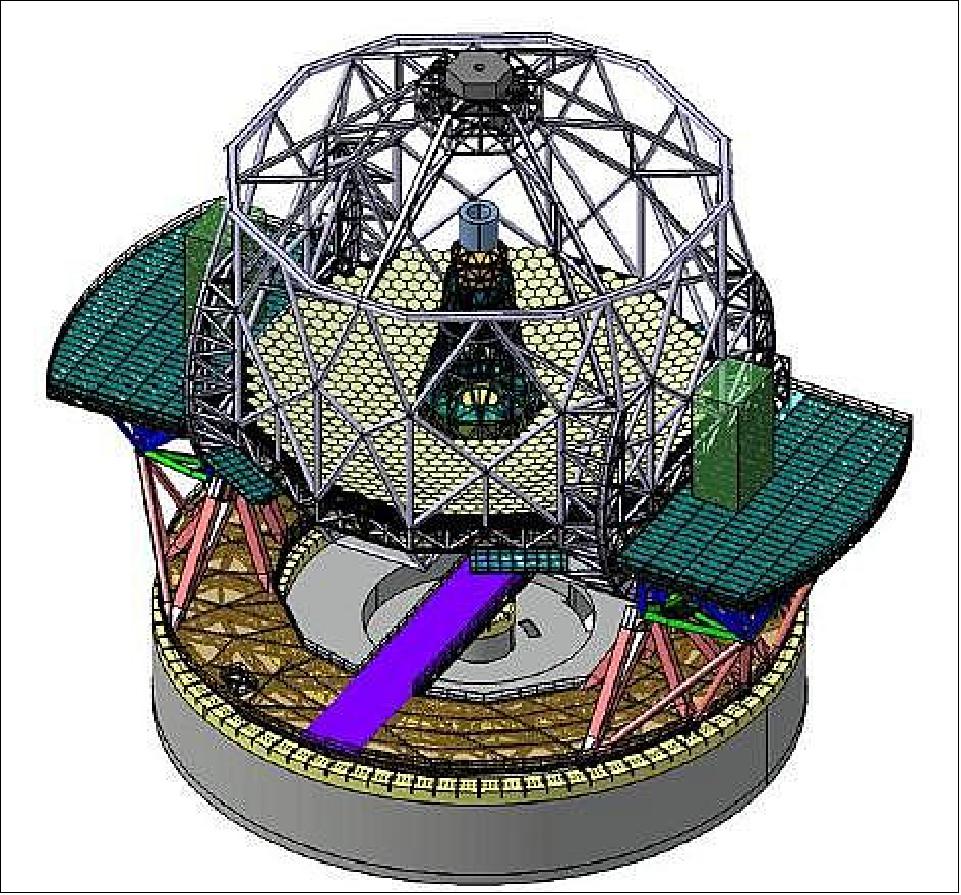
The main structure of the telescope was designed as to comply with critical performance needs, such as pointing and tracking specifications of 1 and 0.3-arcseconds, respectively. It is required that the main structure tracks sufficiently well under wind loads. Another important source of wavefront error is the movement of the secondary units with respect to the primary, and the support of the telescope was designed as to limit both the amplitude and frequency of the M2 unit deflections.
Azimuth structure: The azimuth structure (Figure 7) supports the scientific instruments. It rides on three azimuth rings, of 51.5 m, 34 m and 4.5 m diameter. The two biggest rings support the main vertical reactions during all operational modes. The radial loads are supported by the intermediate ring, while the central ring supports part of the rotating floor. The azimuth structure is made of hollow members and weighs about 1300 t.
The azimuth structure contains also the two Nasmyth platforms, whose dimensions are approximately 12 m x 29 m with a mass of about 150 t. The Nasmyth platforms host the pre-focal stations and provide stable platforms for the post focal instrumentation.

The altitude structure (Figure 8) hosts the telescope optics. It is made of hollow beams and is estimated to weigh approximately 1500 t with the hosted units. The major challenges that have been addressed in the design are the need to keep the primary mirror segments within a reasonable range from their prescribed locations and the need to minimize the deflections of the secondary mirror.
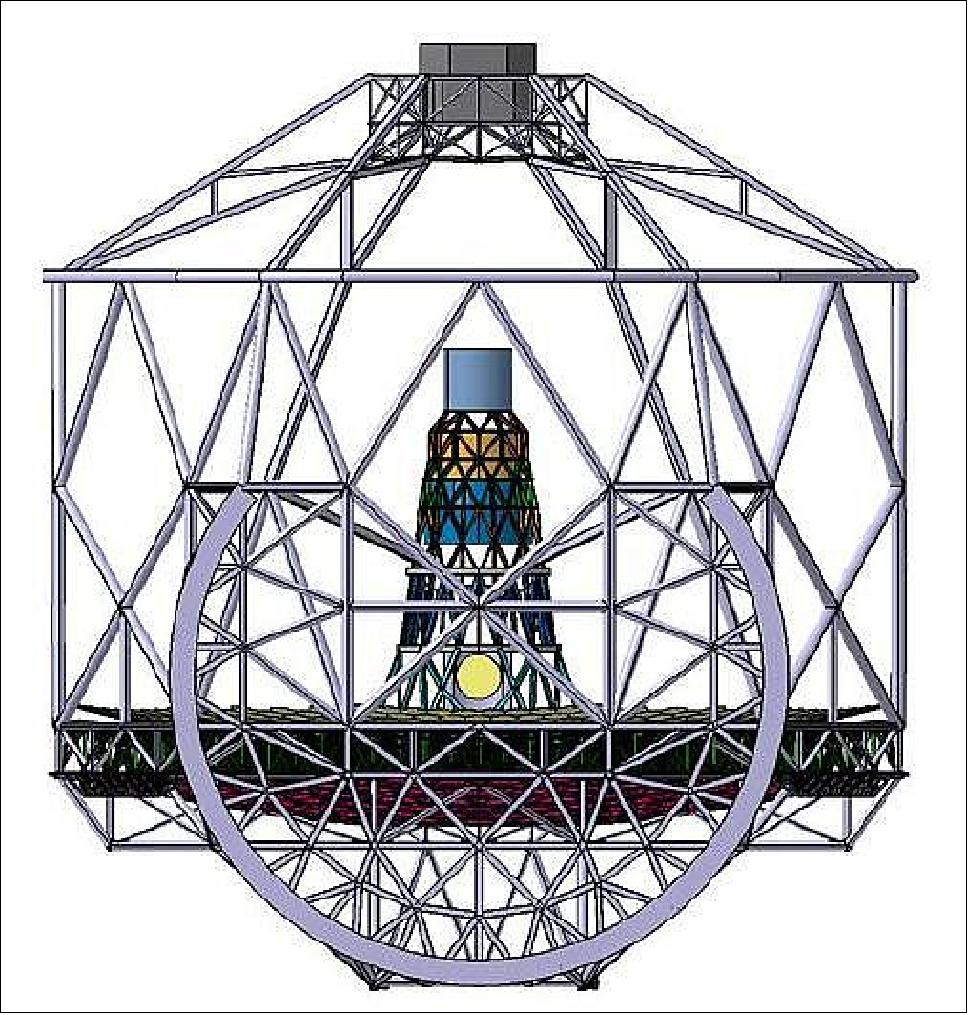
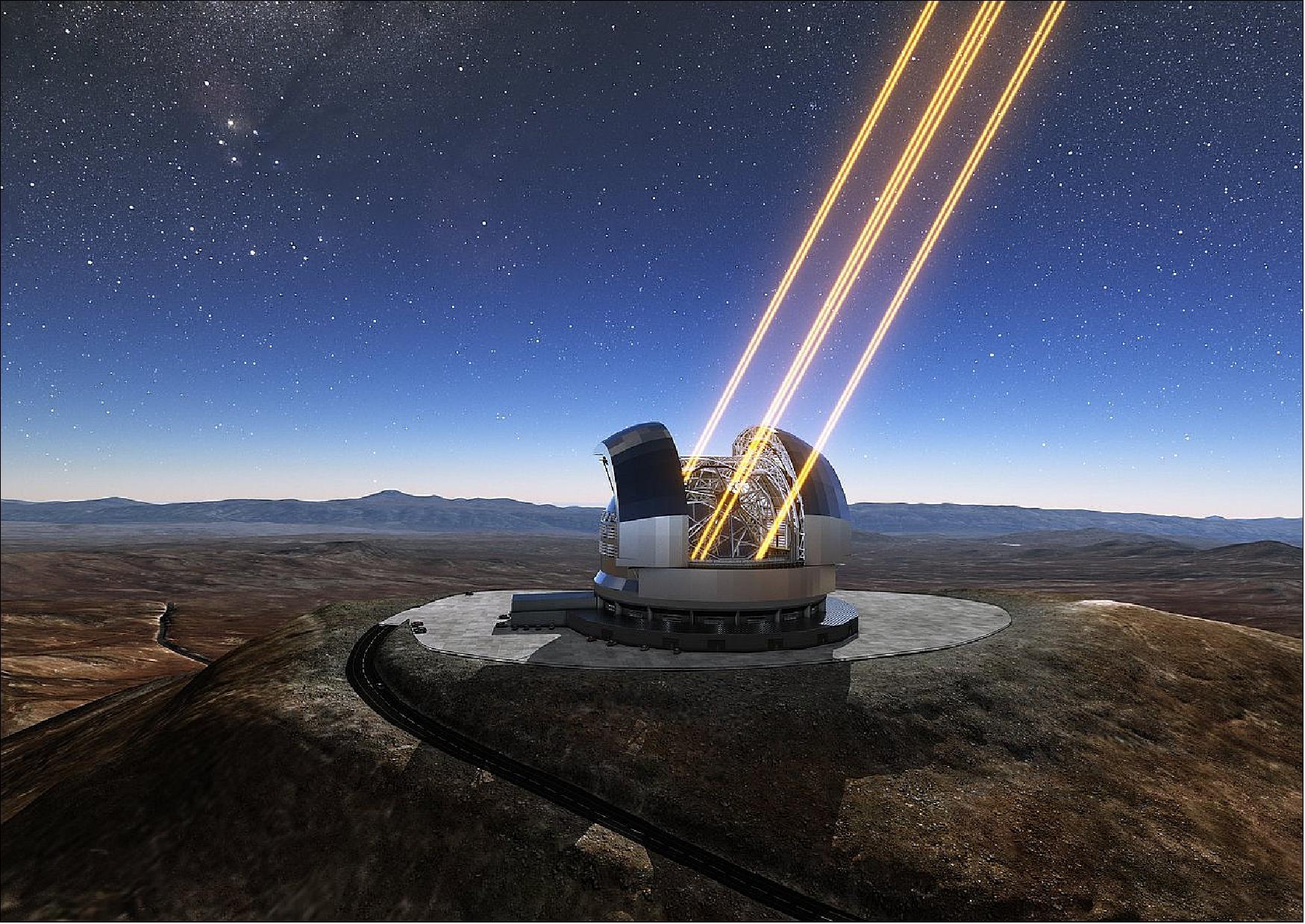
Development Status
• 11 June 2021: Preparations are being put in place to resume construction work on ESO's ELT at Cerro Armazones in Chile, following disruption due to the COVID-19 pandemic, which forced the closure of the site in mid-2020. As work on manufacturing and design elements of the ELT in Europe progressed steadily, the evolution of this complex and ambitious project, set to revolutionize modern astronomy, has been closely monitored over the past year. ESO's ELT is now expected to deliver the first scientific observations in September 2027, about half a year after an initial "telescope technical first light". 6)
- In the last few weeks, the Italian consortium ACe (Cimolai, Astaldi) in charge of the dome and main structure construction, has started preparations to resume on-site activities on ESO's ELT in the Chilean Atacama Desert, within the health and safety restrictions established by the country's authorities. With this important return to work in Chile, it has been possible to assess the first impact the global pandemic has had on the ELT schedule. Most of the project work across Europe continued despite the adverse and changeable pandemic situation since early 2020, but the construction schedule of the telescope has so far suffered a delay estimated to be around a year and a half.
- Once completed, ESO's ELT will be the largest optical telescope in the world, collecting more light than all of the existing 8–10-meter class telescopes on the planet combined. With its 39-meter main mirror and unique five-mirror design, coupled with state-of-the-art technology to correct for atmospheric distortions, it will provide images 15 times sharper than those from the Hubble Space Telescope. ESO's ELT will be used to push scientific boundaries in fields such as habitable exoplanet discovery, galaxy formation or the study of dark energy and dark matter.
- The scientific capabilities of ESO's ELT will be unaffected by this new construction schedule, and once it begins scientific operations, the ELT will tackle the biggest astronomical challenges of our time and make discoveries which are currently unimaginable.
• 4 December 2020: The Extremely Large Telescope (ELT), ESO's new flagship telescope being built to answer the biggest questions about our Universe, has received a 10% increase to its budget. The funding boost approved by the ESO Council — the organization's main governing body — brings the total cost of the project to € 1.3 billion. The 39-meter telescope, being erected in Cerro Armazones near ESO's Paranal Observatory in northern Chile, will start operating later this decade. 7)
"Council's decision means ESO has the funds to build an ambitious and extremely powerful science machine, fully integrated with ESO's Paranal Observatory, that meets the longer-term aspirations of the astronomy community," says ESO Director General Xavier Barcons. Overall, 80% of the ELT's budget is being invested in contracts with industry in ESO member states and in Chile.
- The funding boost will strengthen the scientific capabilities of the under-construction telescope, bringing them in line with those envisioned in the original ELT program approved by Council in 2012. Two years later, ESO Council gave green light for ELT construction but stipulated that it should occur in two phases, with funding only committed for a fully working but less-powerful ‘Phase 1 ELT'.
- The revised budget includes the procurement of components originally deferred to the second phase of the project, such as the telescope's second prefocal station, two more laser guide star systems, a set of astronomy-relevant atmospheric monitoring equipment and a small technical building at Armazones to optimize operations and maintenance activities. The new budget incorporates the impact on cost and schedule of known technical risks and includes the cost of activities needed to bring the ELT into operation as part of ESO's Paranal Observatory.
- The funding boost follows an ELT total cost exercise that started in 2019. The exercise is an example of ESO's continuous monitoring of the project and dedication to delivering a pioneering telescope that will tackle the biggest astronomical challenges of our time and make yet unimaginable discoveries. A truly international endeavor, this ambitious and exciting ESO project is made possible thanks to the organization's staff and governing bodies, the astronomy community, industry and scientific institutions in member states, as well as to the host state of Chile.
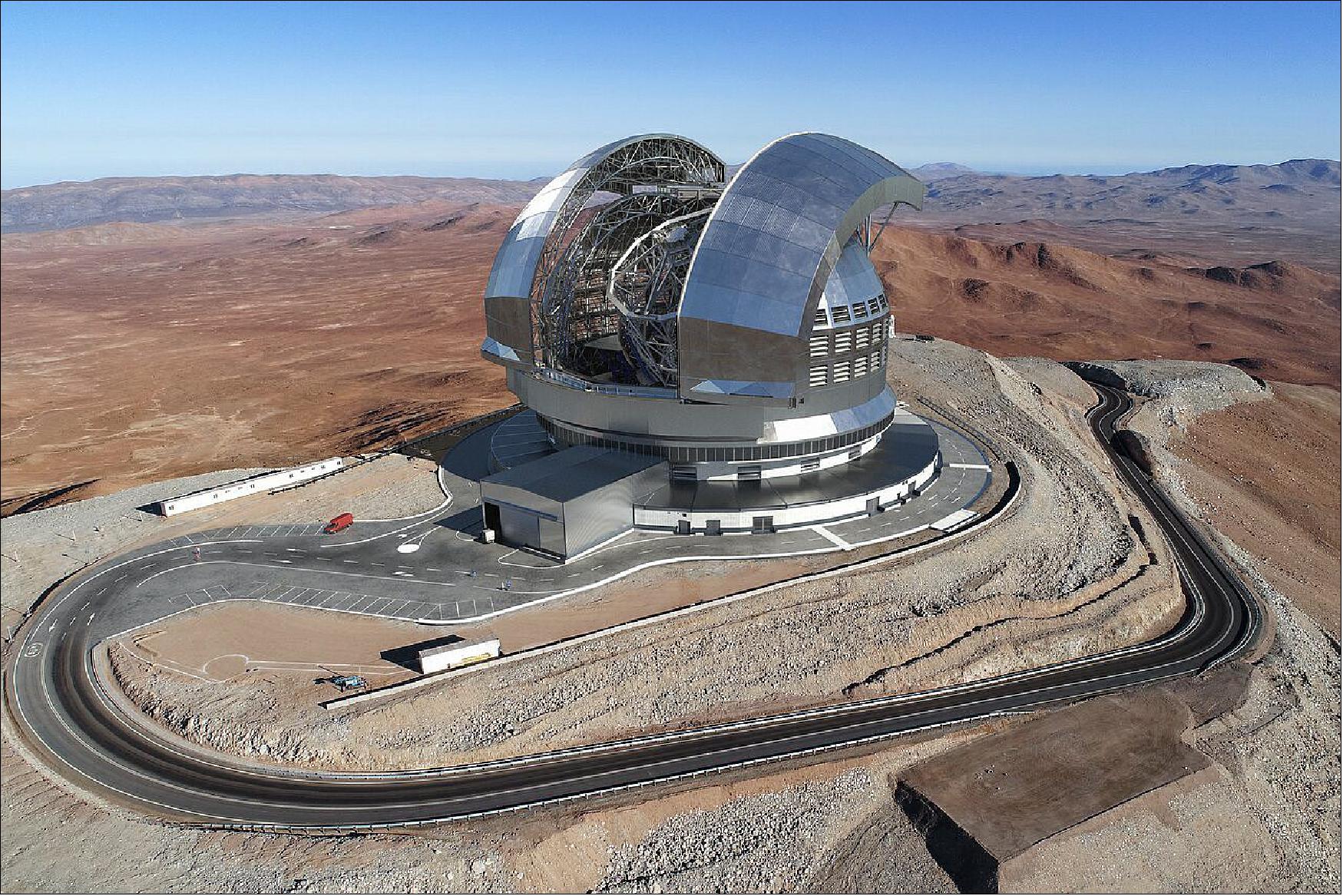
• 2 August 2019: The first set of 18 blanks for the primary mirror of ESO's Extremely Large Telescope have arrived safely at Safran Reosc in Poitiers, France. The contracts for casting the blanks of the mirror segments, as well as polishing, mounting and testing them, were signed in 2017 with, respectively, the German company Schott and the French company Safran Reosc, a subsidiary of Safran Electronics & Defense. 8)
- Mirror blanks are packed by six into a special wooden transport crate, and six of these crates can fit inside a regular shipping container. Sophisticated shock sensors travel with the blanks to measure any sudden acceleration or shock that could affect the blanks.
- The shipping container with the first 18 blanks was sent from SCHOTT in Mainz, Germany, on 23 July and arrived at Safran Reosc the following day. The ELT mirror blanks are made of the low-expansion glass-ceramic Zerodur© and are circular, measuring 1.5 m across and about 5 cm thick. The back of each blank is flat and the front surface is concave. The blanks come in three types with slightly differently shaped front surfaces, depending on the planned location of the segment in the primary mirror. The first primary mirror segments were cast by SCHOTT in 2018.
- SCHOTT manufactures the blanks to approximate shape so that Safran Reosc does not need to remove too much material during the polishing process. Safran Reosc will polish the blanks before they are cut into hexagons and receive a final precise polishing using Ion Beam Figuring.
- When it is completed, the primary mirror will comprise 798 hexagonal segments and will have a total light-collecting area of 978 m2. In total, more than 900 segments will need to be cast and polished (including a spare set of 133 segments).
- Once built the ELT will be the largest ground-based telescope in operation. The telescope is being built at Cerro Armazones in the Atacama Desert of northern Chile. With a primary mirror almost 40 m in diameter, the ELT will gather almost 100 million times more light than the human eye, which will allow scientists to tackle some of the biggest challenges in current astrophysics, such as the formation of the first stars, the assembly of the first galaxies, the characterization of the atmospheres of Earth-like exoplanets, or the nature of dark matter and dark energy, among many other questions.

• 29 October 2018: ESO's ELT (Extremely Large Telescope) is currently under construction in the remote Chilean Atacama Desert; this groundbreaking telescope alone will collect more light than over 200 NASA/ESA Hubble Space Telescopes. 9)
- Finding a suitable place for such a structure was also no easy task. As well as requiring the dry and light-pollution-free conditions at a high altitude necessary for successful astronomy, the ELT needed a huge space on which to spread its foundations. As such a location was not available, it was created! The complex journey of the ELT's construction began by flattening the top of the Cerro Armazones mountain in Chile, taking 18 meters off its full height. That site is now covered by a web of foundations — as seen in this image (Figure 12).
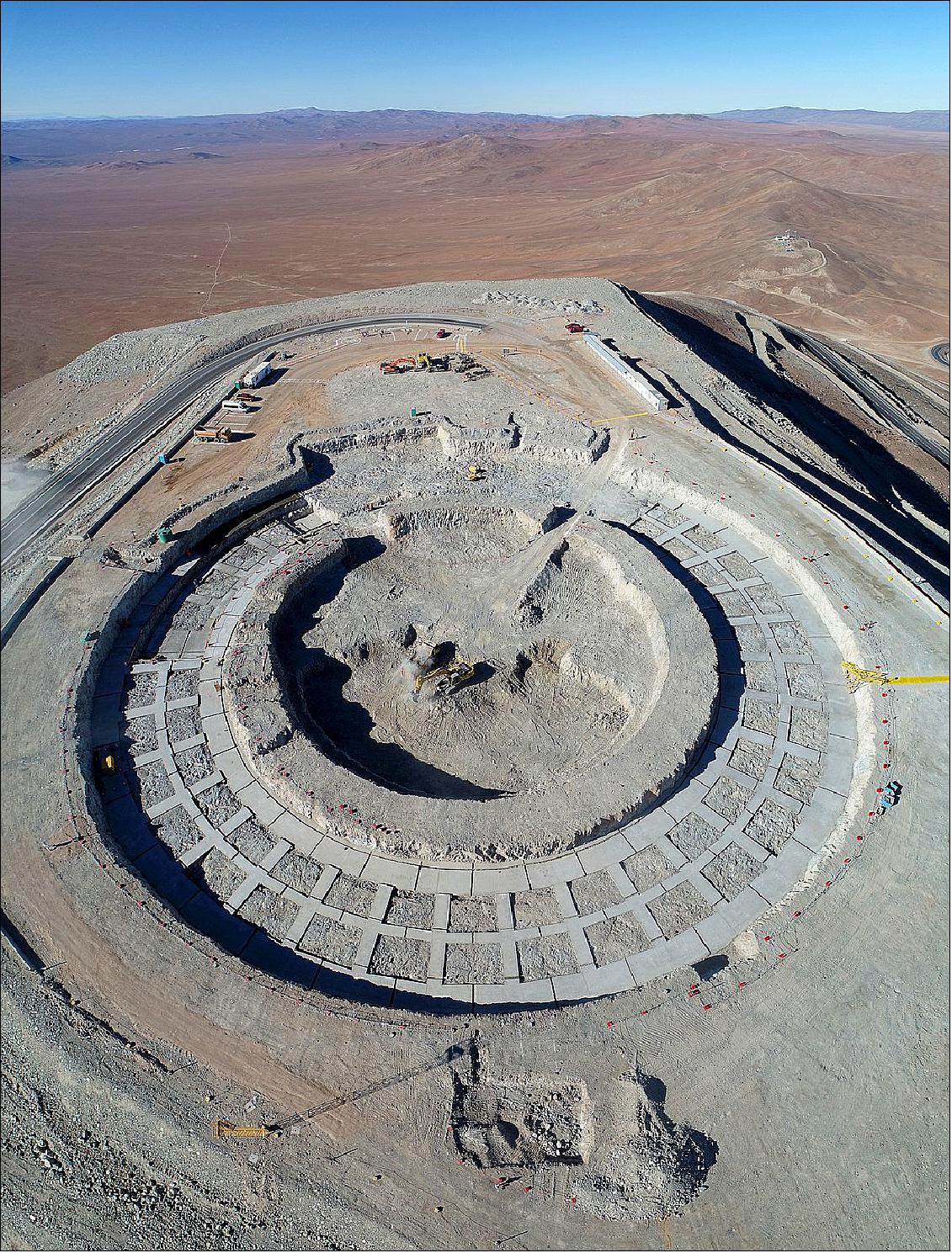
• 9 January 2018: The 39 m diameter primary mirror of ESO's Extremely Large Telescope will be by far the largest ever made for an optical-infrared telescope. Such a giant is much too large to be made from a single piece of glass, so it will consist of 798 individual hexagonal segments, each measuring 1.4 m across and about 5 cm thick. The segments will work together as a single huge mirror to collect tens of millions of times as much light as the human eye. 10)
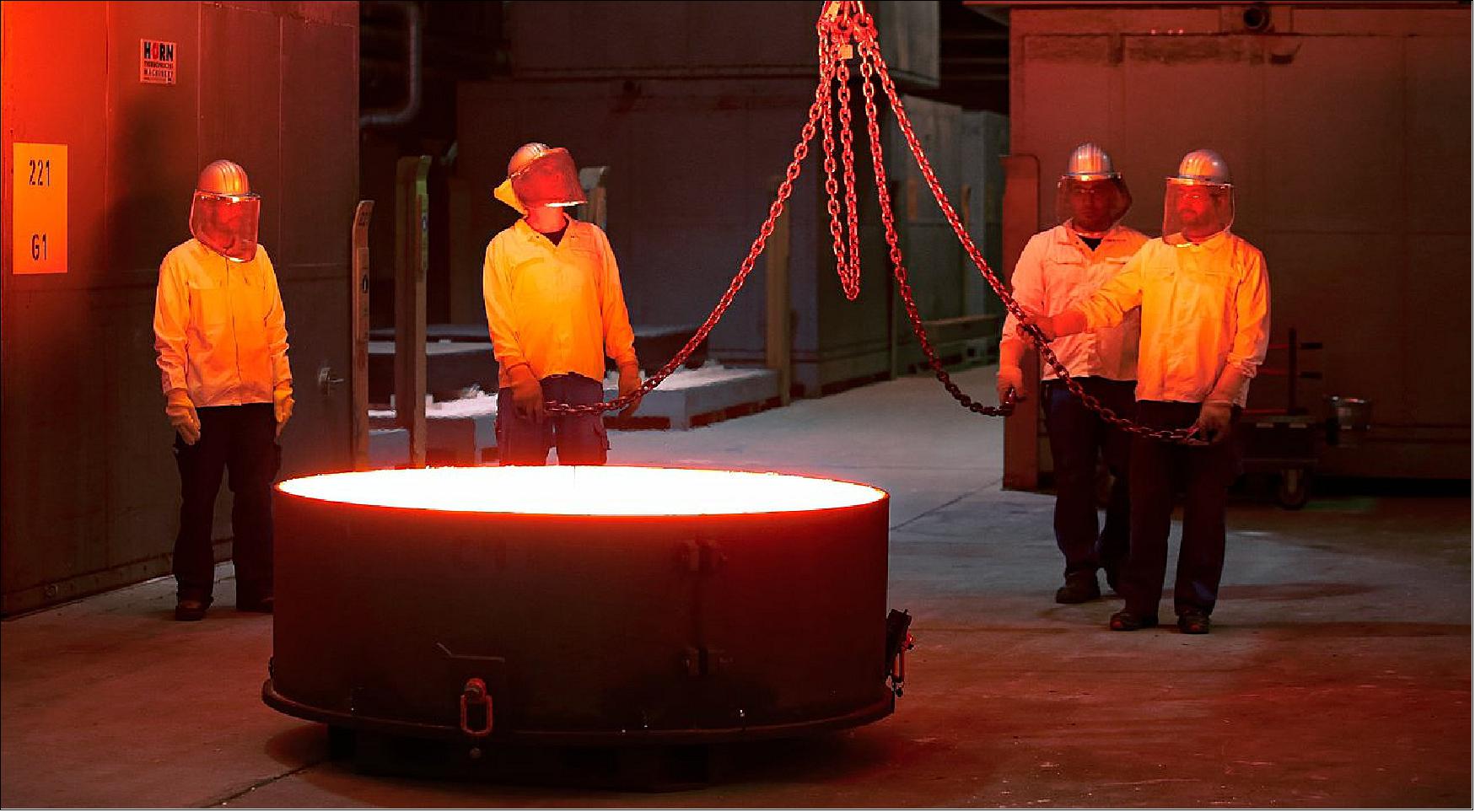
- Marc Cayrel, head of ELT optomechanics at ESO, was present at the first castings: "It was a wonderful feeling to see the first segments being successfully cast. This is a major milestone for the ELT!"
- As with the telescope's secondary mirror blank, the ELT main mirror segments are made from the low-expansion ceramic material Zerodur© [1] from SCHOTT. ESO has awarded this German company with contracts to manufacture the blanks of the first four ELT mirrors (known as M1 to M4, with M1 being the primary mirror) (eso1704).
Notes:[1] Zerodur© was originally developed for astronomical telescopes in the late 1960s. It has an extremely low coefficient of thermal expansion, meaning that even in the case of large temperature fluctuations, the material does not expand. Chemically, Zerodur© is very resistant and can be polished to a high standard of finish. The actual reflective layer, made of aluminium or silver, is usually vaporised onto the extremely smooth surface shortly before a telescope is put into operation and at regular intervals afterwards. Many well-known telescopes with Zerodur© mirrors have been operating reliably for decades, including ESO's Very Large Telescope in Chile.
- The first segment castings are important as they allow the engineers at SCHOTT to validate and optimize the manufacturing process and the associated tools and procedures.
- The casting of the first six segments is a major milestone, but the road ahead is long — in total more than 900 segments will need to be cast and polished (798 for the main mirror itself, plus a spare set of 133). When fully up to speed, the production rate will be about one segment per day.
- After casting, the mirror segment blanks will go through a slow cooling and heat treatment sequence and will then be ground to the right shape and polished to a precision of 15 nanometres across the entire optical surface. The shaping and polishing will be performed by the French company Safran Reosc, which will also be responsible for additional testing (eso1717).
• 12 June 2017: Up to now ESO's giant telescope project has been referred to as the E-ELT (European Extremely Large Telescope), but this name, which was always intended to be interim and not final, is becoming less appropriate. 11)
- To address this as the project moves rapidly forward into the construction phase, the organization has decided on a shorter name. Instead of the European Extremely Large Telescope, the world's biggest eye on the sky will now be known simply as the ELT (Extremely Large Telescope).
- The new name, as well as being shorter and easier to say, reflects the growing number of ESO's international partners, both at national level and as regards the commercial companies involved in the project, and also the fact that the telescope is located in Chile.
- While older material may continue to refer to the telescope by its original name, ESO will be using the new name from now on and strongly encourages its use in all future material.
• 18 January 2017: This diagram (Figure 14) shows the novel 5-mirror optical system of ESO's Extremely Large Telescope (ELT). Before reaching the science instruments the light is first reflected from the telescope's giant concave 39 m segmented primary mirror (M1), it then bounces off two further 4 m-class mirrors, one convex (M2) and one concave (M3). The final two mirrors (M4 and M5) form a built-in adaptive optics system to allow extremely sharp images to be formed at the final focal plane. Contracts for the casting of the M2 and M3 mirrors, their cells and sensors for the M1 segments were awarded at a ceremony at ESO's Garching Headquarters in January 2017. 12)
- Introducing the ceremony, Tim de Zeeuw said: "It gives me great pleasure to sign these four contracts today, each for advanced components at the heart of the ELT's revolutionary optical system. They underline how the construction of this giant telescope is moving ahead at full speed — on target for first light in 2024. We at ESO look forward to working with SCHOTT, SENER and FAMES — three leading industrial partners from our Member States."
- The first two contracts were signed with SCHOTT by Christoph Fark, Executive Vice President. They cover the casting of the ELT's largest single mirrors — the 4.2 m secondary and 3.8 m tertiary mirror — from SCHOTT's low-expansion ceramic material Zerodur©.
- Hanging upside-down at the top of the telescope structure, high above the 39 m primary mirror, the secondary mirror will be largest ever employed on a telescope and the largest convex mirror ever produced. The concave tertiary mirror is also an unusual feature of the telescope. The ELT secondary and tertiary mirrors will rival in size the primary mirrors of many modern-day research telescopes and weigh 3.5 and 3.2 tons, respectively. The secondary mirror is to be delivered by the end of 2018 and the tertiary by July 2019.
- The third contract was signed with the SENER Group by Diego Rodríguez, Space Department Director. It covers the provision of the sophisticated support cells for the ELT secondary and tertiary mirrors and the associated complex active optics systems that will ensure these massive, but flexible, mirrors retain their correct shapes and are correctly positioned within the telescope. Great precision is needed if the telescope is to deliver optimum image quality.
- The fourth contract was signed by Didier Rozière, Managing Director (FAMES, Fogale), and Martin Sellen, Managing Director (FAMES, Micro-Epsilon), on behalf of the FAMES consortium, which is composed of Fogale and Micro-Epsilon. The contract covers the fabrication of a total of 4608 edge sensors for the 798 hexagonal segments of the ELT's primary mirror.
- These sensors are the most accurate ever used in a telescope and can measure relative positions to an accuracy of a few nanometres. They form a fundamental part of the very complex system that will continuously sense the locations of the ELT primary mirror segments relative to their neighbours and allow the segments to work together to form a perfect imaging system. It is a huge challenge not only to make sensors with the required precision, but also to produce them quickly enough for thousands to be delivered to the necessarily short timescales.
- The signing ceremony was also attended by other senior representatives of the companies involved and ESO. It was an excellent opportunity for representatives of the contractors producing many of the giant telescope's optical and mechanical components to get to know each other informally as they begin to help create the world's biggest eye on the sky.
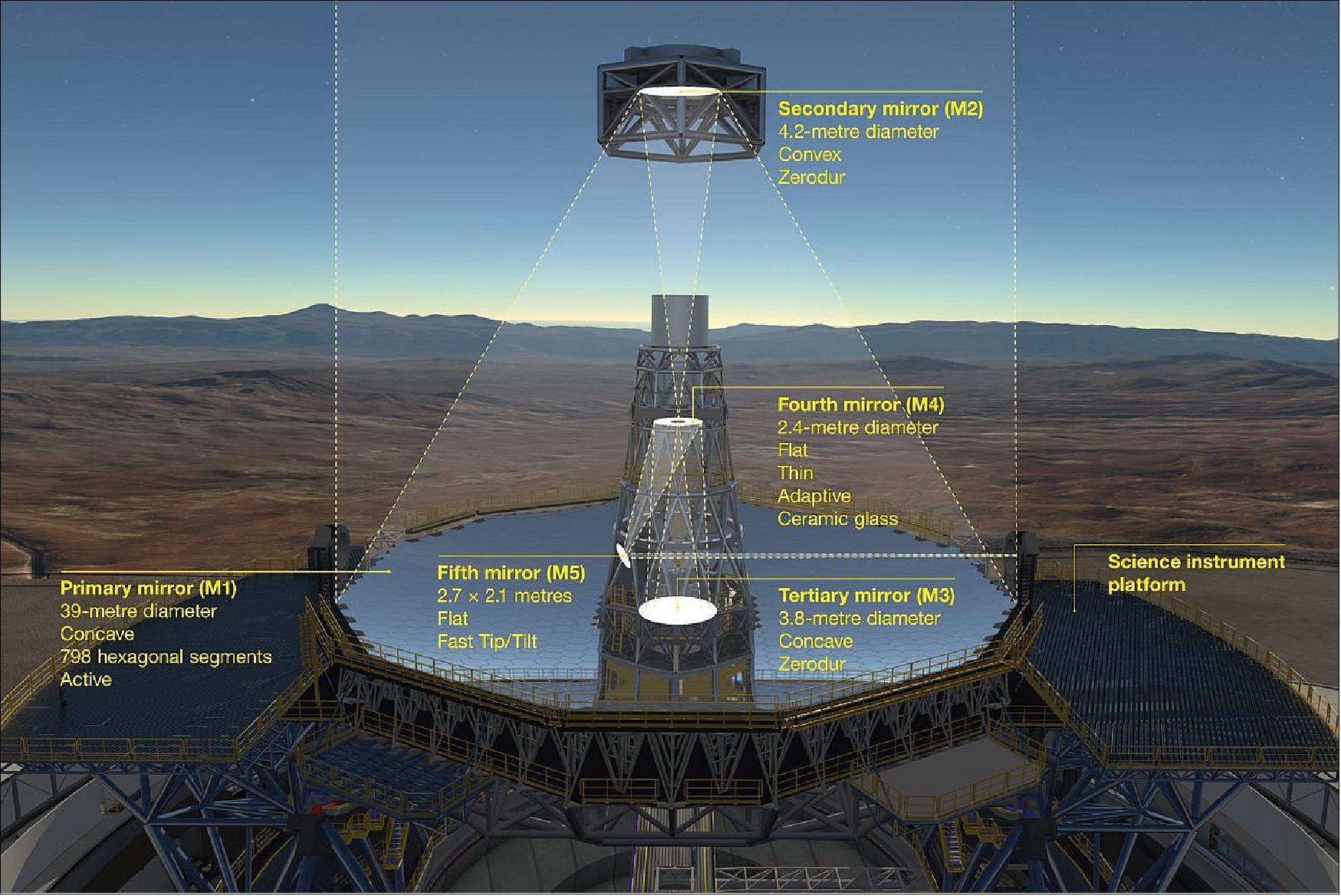
• On 26 April 2010, the ESO Council selected Cerro Armazones as the baseline site for the planned 40 m European Extremely Large Telescope (E-ELT). Cerro Armazones is a mountain at an altitude of 3060 m in the central part of Chile's Atacama Desert, some 130 km south of the town of Antofagasta and about 20 km from Cerro Paranal, home of ESO's VLT (Very Large Telescope). 13)
- "This is an important milestone that allows us to finalise the baseline design of this very ambitious project, which will vastly advance astronomical knowledge," says Tim de Zeeuw, ESO's Director General. "I thank the site selection team for the tremendous work they have done over the past few years."
Sensor Complement
HARMONI (High Angular Resolution Monolithic Optical and Near-infrared Integral field spectrograph)
HARMONI will be one of the first generation of ELT instruments and will transform the visible and near-infrared astronomy landscape. This workhorse instrument, a 3D spectrograph, will disperse the light from astronomical objects into its component wavelengths, allowing scientists to study them in fine detail and go beyond what we can achieve with current spectrographs. 14)
Powerful and versatile, HARMONI will enable astronomers to study many different astronomical targets, from the far-off — distant galaxies, energetic quasars, and gamma-ray bursts — to individual stars in nearby galaxies and exoplanets in the Milky Way. HARMONI will provide visible and near-infrared spectroscopy over a range of resolving powers and spatial scales and can work both with and without adaptive optics.
Science with HARMONI: Large-area galaxy surveys have allowed us to study the global properties of galaxies at high-redshift, that is, galaxies that are very far away and thus far back in cosmic time. However, we have very little data to test the physical mechanisms at work, as probing the internal structure of galaxies is largely beyond our current capabilities. By studying the properties of these distant galaxies (internal kinematics, internal stellar population gradients, dust distribution, ionization structure, nuclear properties, and interaction with the intergalactic medium), HARMONI will show how the different physical processes involved are related, and how they give rise to the physical properties we observe.
By probing the processes occurring within galaxies on the scale of individual star-forming regions, HARMONI also promises to help astronomers study the star formation, gas dynamics, metallicity and gas outflows of very distant galaxies in unprecedented detail. Moreover, the same data will tell us what fraction of galaxies at redshift z=2 have settled into stable, rotating disks and how individual episodes of star formation are related to outflowing winds, accretion of matter or steady evolution. This gives astronomers the opportunity to understand what physical mechanisms drive the star formation rate to peak at this redshift, which corresponds to a look-back time of about 10.3 billion years.
In addition, HARMONI's high angular resolution mode will help astronomers probe the environment surrounding galaxy nuclei, revealing not only the relationship between Active Galactic Nucleus (AGN) activity and star formation, but also opening up the opportunity to estimate the mass of the central supermassive black hole.
Consortium: HARMONI is made possible through an international consortium composed of research institutes from four different countries. The institutes that make up the HARMONI consortium are the University of Oxford (Oxford, United Kingdom), the UK Astronomy Technology Centre (Edinburgh, United Kingdom), the Durham University (UK), the Lyon Centre for Astrophysics Research (Lyon, France), the Marseille Astrophysics Laboratory (Marseille, France), the Canary Islands Institute of Astrophysics (Santa Cruz de Tenerife, Spain), the Spanish Astrobiology Centre (Torrejón de Ardoz, Spain), the University of Michigan (Ann Arbor, Michigan, US), the French Aerospace Lab (ONERA, France), the Grenoble Institute for Planetary Sciences and Astrophysics (IPAG) and the Toulouse Institute for Planetary Sciences and Astrophysics (IRAP).
Instrument Design: With its 3D spectroscopic capabilities and a variety of spatial and spectral settings, HARMONI will be a very powerful and versatile first-generation instrument for the ELT.
HARMONI will use an Integral Field Unit (IFU) with an image slicer to divide a single contiguous field of view into many spatial pixels (called spaxels). The signal from each spaxel will be fed into a spectrograph that generates a spectrum for each one of them. Astronomers will be able to choose between four spaxel scales (from 4 mas to 60 mas) that result in different fields of view - with smaller spaxels comes a smaller field of view but a higher spatial resolution. This makes HARMONI very versatile.
Astronomers will also be able to choose between a range of spectral resolution settings (3000, 7000, 18000) available in all spatial scales covering wavelengths between 0.47 µm and 2.45 µm, though not simultaneously. The instrument will be able to work with two different adaptive optics systems that will correct for atmospheric turbulence: single-conjugate adaptive optics (SCAO) that uses a bright(R≤16) reference star to provide high Strehl image quality over a small fraction of the sky, and laser tomography adaptive optics (LTAO) that combines laser guide stars with fainter natural stars to deliver diffraction-limited image quality in the JHK bands over a large fraction of the sky.
HARMONI will be located at the "side-looking" Nasmyth port of the ELT. The first element in the optical path is a user-selectable dichroic that separates the light at the wavelength of about 600 nm used by the laser guide stars to enable LTAO observations from the science and natural guide stars light. This dichroic will be removed in case of science observations at visible wavelength below 600 nm. When using LTAO, the reflected laser light is redirected to a rotating Laser Guide Star Sensing system, which contains six laser guide star wavefront sensors. The light transmitted by the dichroic over a field of view of 120 arcsec in diameter for science and pick-up of the natural guide stars is relayed towards the instrument by using cold relay optics, to minimize the thermal background.
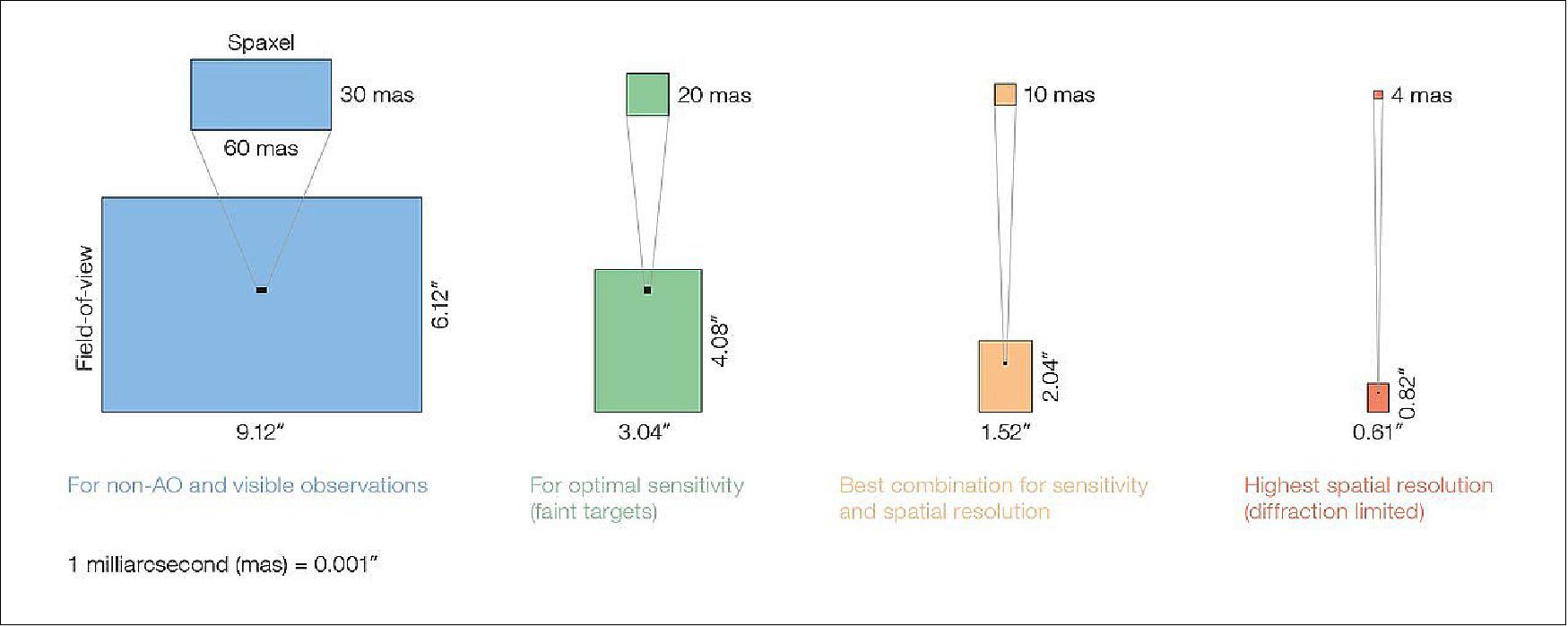
Wavelength | 0.47—2.45 µm |
Spectral resolution | ~3,500, 7,500, and 18,000 in the NIR and ~3,500 in the VIS bands |
Simultaneous spectral range | at least one band at a time R~7,500 (i, z, J, H, K), two at R~3,500 |
FOV (Field of View) | four, corresponding to different spaxel scales |
AO (Adaptive Optics) | LTAO (Laser Tomography Adaptive Optics) and SCAO (Single-Conjugate Adaptive Optics) |
The bulk of the HARMONI's optical and mechanical parts is hosted in a single up-looking gravity invariant cryostat cooled to a low temperature of around 140 K. A subsystem of pre-optics provides four selectable spaxel scales, as well as filters and pupil masks. The light from the entire field is then reformatted into four linear slits by the IFU subsystem, each of which feeds one of four spectrograph subsystems. Each spectrograph then collimates, disperses, and focuses the light onto a pair of 4k x 4k detectors, providing a choice of spectral ranges and resolving powers.
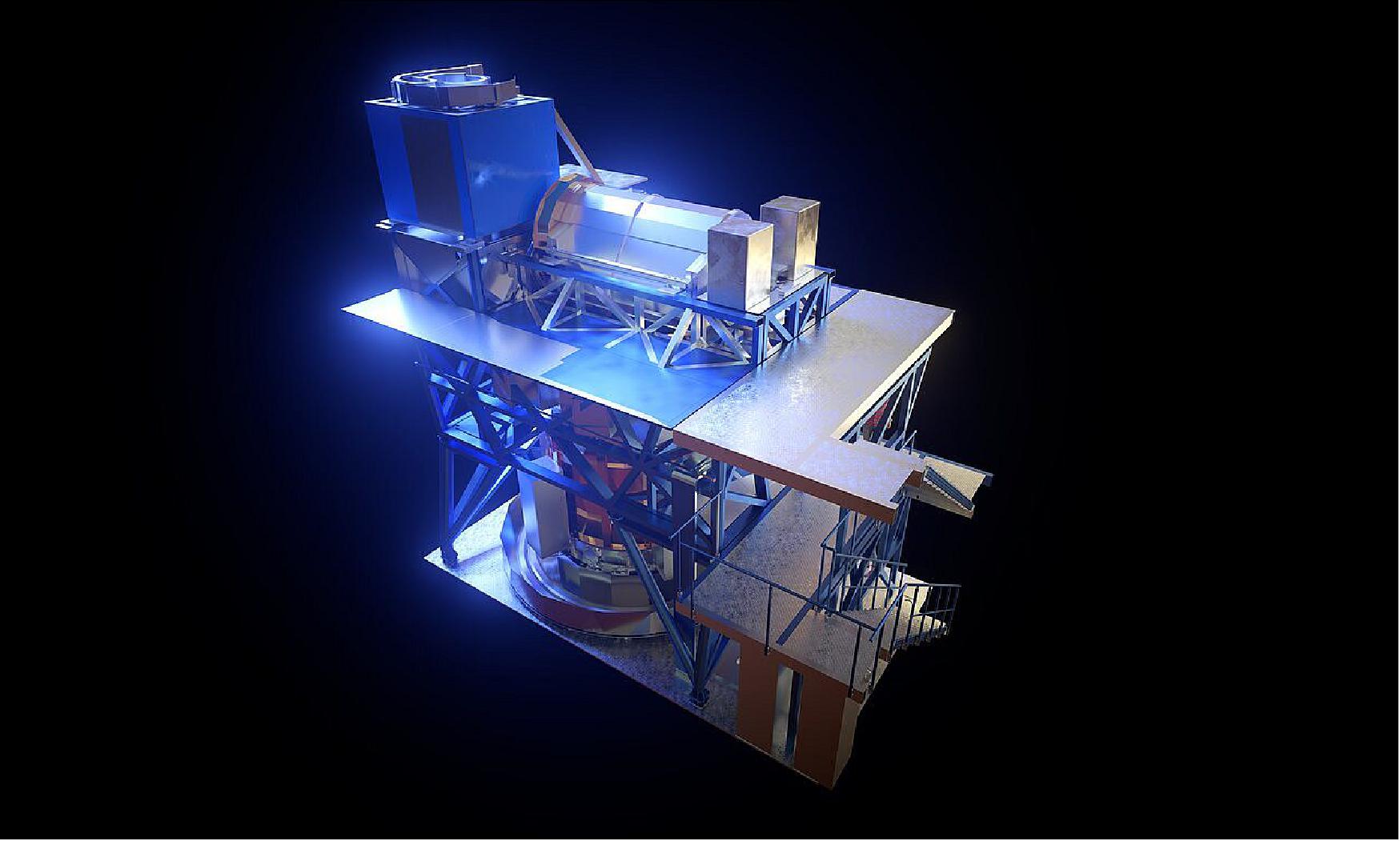
MICADO (Multi-AO Imaging Camera for Deep Observations)
MICADO will make the most of the giant ELT's full resolution potential to advance many areas of astronomy. Astronomers will use it to image the detailed structure of distant galaxies, study individual stars in nearby galaxies, and — using a coronagraph to block starlight — discover and characterize exoplanets. MICADO will also be a unique powerful tool for exploring environments where gravitational forces are extremely strong, such as close to the supermassive black hole at the center of our galaxy, the Milky Way. 15)
MICADO will offer astronomers the ability to take images at an unprecedented depth, thanks to the combination of the ELT's large primary mirror and the correction for the blurring effect of the atmosphere that will be provided by the MAORY adaptive-optics system. The instrument's high-tech features will enable it to go far beyond the capabilities of the best observatories that we have today, including the Hubble Space Telescope (HST) and its sensitivity will be comparable to the James Webb Space Telescope (JWST) but with six times the resolution.
Consortium: The MICADO consortium consists of: Max-Planck-Institut für extraterrestrische Physik (MPE, Germany), Max-Planck-Institut für Astronomie (MPIA, Germany), Universitäts-Sternwarte München (USM, Germany), Institut für Astrophysik Göttingen (IAG, Germany), Nederlandse Onderzoekschool voor Astronomie (NOVA, The Netherlands), Osservatorio Astronomico di Padova-INAF (OAPD, Italy), CNRS/INSU (with contributions by LESIA, GEPI and IPAG, France) and A*, a collaboration represented by the Universities of Vienna, Innsbruck and Linz (Austria).
Science with MICADO: Directly after the Big Bang there was no structure in the Universe, no individual stars, and no galaxies. Discovering how the Universe evolved from this state to the rich population of stars and galaxies that we see today is a key area of astronomical research. To understand galaxy growth, astronomers study the number and type of stars in galaxies at different distances. MICADO's high spatial resolution will allow very small and distant objects to be resolved, allowing astronomers to study the population of stars in galaxies beyond our immediate Galactic neighborhood.
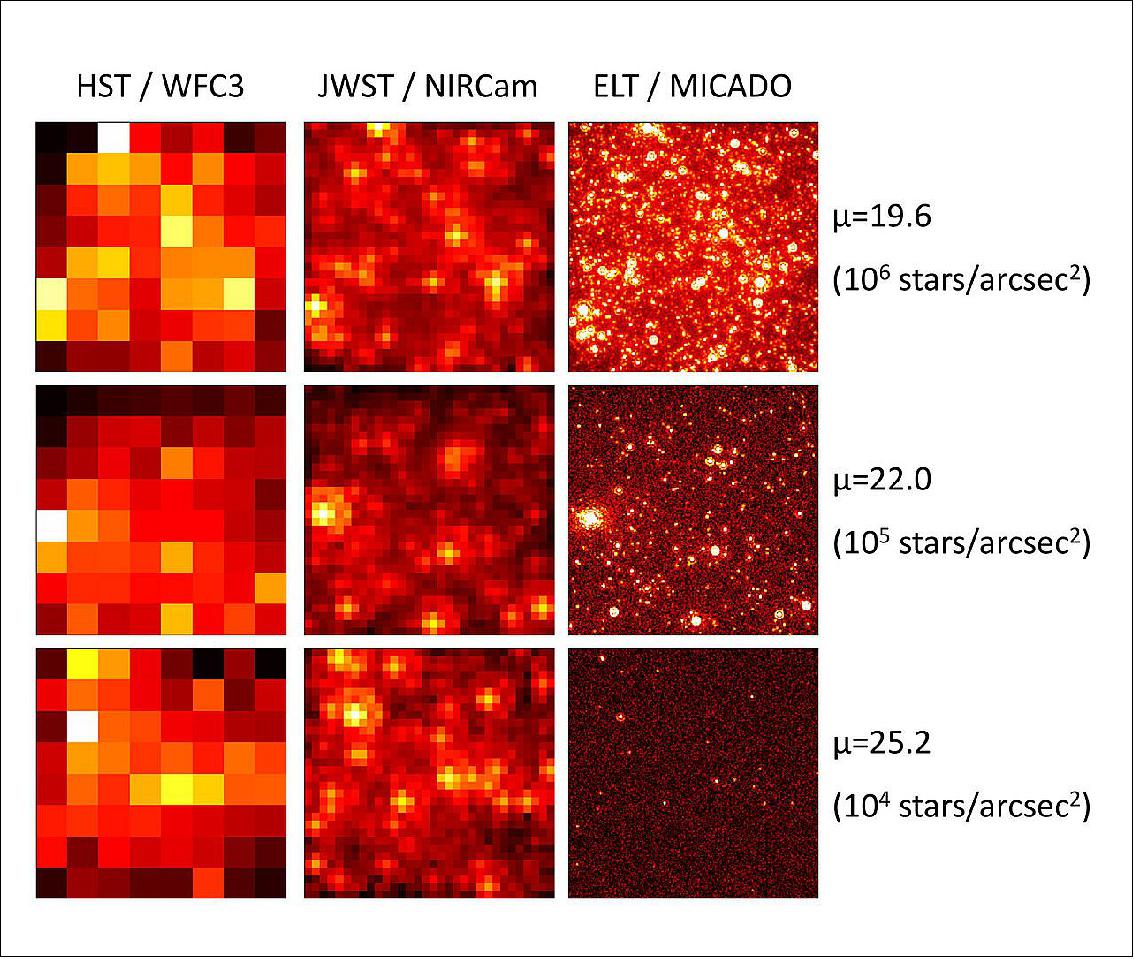
MICADO has the potential to address a large number of science topics that span the key elements of modern astrophysics, and has clear synergies with other facilities and instruments such as ALMA, HARMONI, and METIS.7The science drivers for MICADO cover six main themes: (i) galaxy evolution at high redshift, (ii) black holes in galaxy centers, including the Galactic Center, (iii) resolved stellar populations, including photometry in galaxy nuclei, the initial mass function in young star clusters, and intermediate mass black holes in globular clusters, (iv) characterization of exoplanets and circum-nuclear disks at small angular scales, (v) the solar system,and (vi) time resolved phenomena around neutron stars and stellar mass black holes.
Instrument design: MICADO will work with the ELT's adaptive-optics module, MAORY, to reach its ambitious science goals. The instrument will offer astronomers a large selection of filters for different types of imaging, including high contrast imaging and mode and single-slit spectroscopy. It will be housed in a cryostat to keep it cool so that it can work effectively at near-infrared wavelengths. 16)
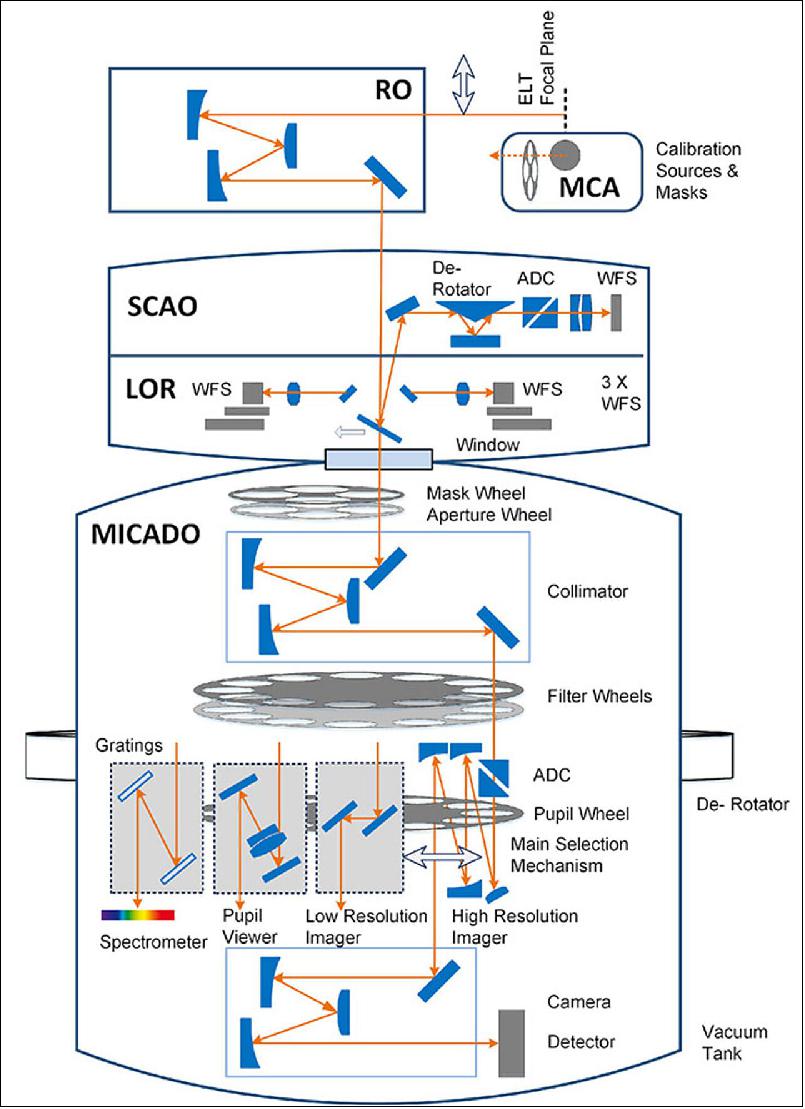
Light from the telescope will enter the top of the MICADO housing. In SCAO mode, light at visible wavelengths will be selected and directed to a wavefront sensor. The real time computer will calculate the corrections to be applied to the ELT's adaptive mirror (M4) to provide a sharp image. In MCAO mode, the beam will pass into the wavefront sensing module. Three stars needed to provide signals to the telescope M4 and the two additional deformable mirrors in MAORY are selected by pick-off mirrors from a patrol field outside the scientific field of view of MICADO.
The near-infrared part of the beam will always pass into the cryostat. The infrared beam will then be collimated, filtered depending on the wavelength requirements of the astronomical observations being carried out, and passed through one of four exchangeable sets of optical components. The optics required to provide the MICADO narrow-field mode will be fixed; by rotating the Main Selection Mechanism wheel, the astronomer may choose between the wide-field mode optics or the spectrograph optics (including the dispersion gratings). There will also be a set of pupil-viewing optics for testing and checking that MICADO remains aligned with the telescope. Finally, an image of the astronomical field being observed will be formed on a 3 x 3 array of near-infrared sensitive detectors. Each of the nine state-of-the-art detectors will have 4096 x 4096 pixels, each pixel 15 µm x 15 µm in size.
The design of MICADO was driven by a desire for high sensitivity, resolution, astrometric accuracy, and wide wavelength coverage spectroscopy. Offering almost a full arcminute-squared field-of-view with 4 mas pixels to sample the diffraction limit of the ELT, MICADO takes advantage of the wide-field correction and uniform point spread function offered by the multi-conjugate adaptive optics (MCAO) module, MAORY. A second, finer, plate scale (1.5 mas) will be used to help MICADO reach challenging requirements on astrometric precision (50 µas requirement). In addition to a large number of broad and narrow band filters for imaging (up to 30) covering the wavelength range 0.8–2.45 µm, MICADO also offers a wide-band spectroscopic mode for compact objects. In single-slit spectroscopy, MICADO covers this wavelength range with two exposures at spectral resolving powers between 10,000 and 20,000. In common with the other early ELT instruments, it will have a coronographic capability to block starlight so that dimmer objects close to these stars — exoplanets, for example — can be seen more easily. A second adaptive-optics mode, single-conjugate adaptive optics (SCAO) will be provided by MICADO and MAORY. This mode is particularly suited to observations with the coronagraph, as it will provide excellent image quality over a smaller field of view. Since MICADO is designed to observe near-infrared wavelengths, the instrument will be housed in a cryostat and cooled to 80 K using liquid nitrogen.
MICADO is one of the two First-Light Instruments that will switch the ELT into operation. With its two observing modes of imaging and spectroscopy it enables for the first time the analysis of stellar light that will be gathered with the 39 m large aperture of the ELT. 17)
Requirement | Specification | Remark |
Wavelength coverage | 0.8 - 2.4 µm |
|
Imaging system | 3-Mirror-Anastigm.(TMA) | Each at collimator and camera optics |
FOV (Filed of View) | 50 arcsec | Enables study of resolved stellar populations and of high-redshift galaxies |
Imaging quality | 70% Strehl in K-band |
|
Detectors | 9 x H4RG (4K x 4K) | Large format NIR detectors in 3x3 Mosaic |
Spatial Sampling | 4 milli-arcsec [mas] |
|
High resolution mode | 1.5 milli-arcsec [mas] | Spatial sampling increased by zoom optics, |
Distortion | <1.9% | Extreme temporal stability due to astrometry requirements |
Astronomy accuracy | 50 micro-arcsec [µas] | Relative accuracy across the FOV in single exposure |
Spectrometer Resolution | R ~20,000 |
|
Photometric accuracy | 0.03 [mag] | Limited by PSF fitting |
Transmission Efficiency | 50 % - 68 % | Depends on AO performance & thermal background |
System throughput | 30 % - 44 % | Inclusive all 5 telescopes - and the AO-mirrors |
Filters | 2 x 18 Filters | Permanently available |
Mass-budget | 17 metric tons | Total installation |
First Light | 2025 |
|

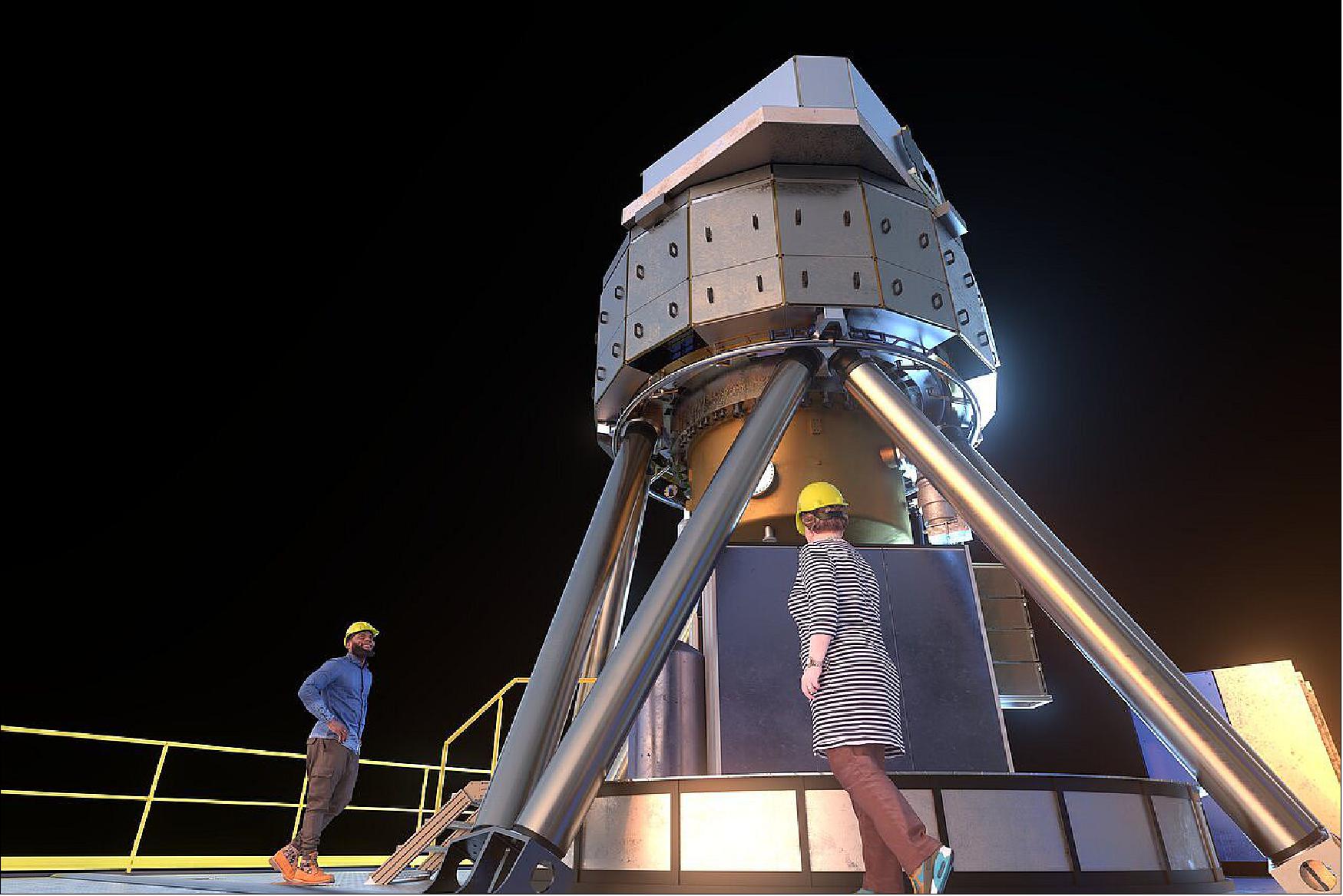
Development Status
• January 21, 2020: The MICADO instrument has passed PDR (Preliminary Design review). A group of experts and the MICADO consortium, including MPIA, met at the ESO headquarters in Garching near Munich for a week of intensive review of the instrument's optics, mechanics, software and electronics to identify areas requiring further design work. The instrument will now go through another detailed design phase before the construction of the individual components can begin. MICADO will produce both images and spectra at wavelengths from 0.8 to 2.4 µm with extremely high positioning accuracy. 18)
- MICADO is the first camera developed specifically for the E-ELT (European Extremely Large Telescope) still under construction, has passed the Preliminary Design Review (PDR). The Max Planck Institute for Astronomy (MPIA) is playing a key role in the development of the instrument. 19)
- A group of experts and the MICADO consortium, including MPIA, met at the ESO headquarters in Garching near Munich for a week of intensive review of the instrument's optics, mechanics, software and electronics to identify areas requiring further design work. The instrument will now go through another detailed design phase before the construction of the individual components can begin. MICADO will produce both images and spectra at wavelengths from 0.8 to 2.4 µm with extremely high positioning accuracy.
- MICADO is supported by an adaptive optical system, MAORY (Multi-conjugate Adaptive Optics RelaY), to improve the quality of observations and reach the diffraction limit of the 39 meter primary mirror. This means that the maximum achievable resolution or image sharpness of a telescope can be used. With adaptive optics, the considerable image blur caused by turbulence in the Earth's atmosphere can be corrected. In this respect, a 39 meter telescope is a huge leap in comparison to the current large telescopes of the 8 meter class.
- The targets are diverse, ranging from exoplanets to galaxies in the early universe and the innermost environments of black holes. MICADO's spectroscopic capabilities will decipher the composition of these objects. The instrument will explore some of the most exciting questions in current astronomy: How are exoplanets formed? How do galactic black holes affect their host galaxies? How has the universe evolved over time?
- When it becomes operational in the mid-2020s, the E-ELT of the European Southern Observatory (ESO), with its 39 meter main mirror, will be the largest optical telescope in the world. The combination of light collection power, angular resolution and astrometric accuracy of better than 50 µarcsec (microarcseconds) with a spatial resolution of 10 marsec and a field of view of 53 arcseconds allows, for the first time, dense stellar distributions in the center of galaxies and star clusters to be measured accurately using kinematics — with a sensitivity previously only provided by space telescopes.
- The MPIA contributes significantly to the MICADO project in general, and to imaging astrometry in particular, which will be complementary to the Gaia satellite of ESA. For example, MPIA is developing the warm pre-optics, which guide starlight from the telescope into the cold camera optics with minimal loss of sensitivity and image sharpness. In addition, MPIA provides the calibration unit for all standard scientific observation modes. During the PDR phase, a prototype in the MPIA laboratory successfully demonstrated that the extreme requirements for image field rotation and calibration can be met. The MICADO team at MPIA in the Department of Galaxies and Cosmology is led by Jörg-Uwe Pott (consortium-wide co-investigator and instrument scientist) as well as the local project manager Ralph Hofferbert and the systems engineer Friedrich Müller.
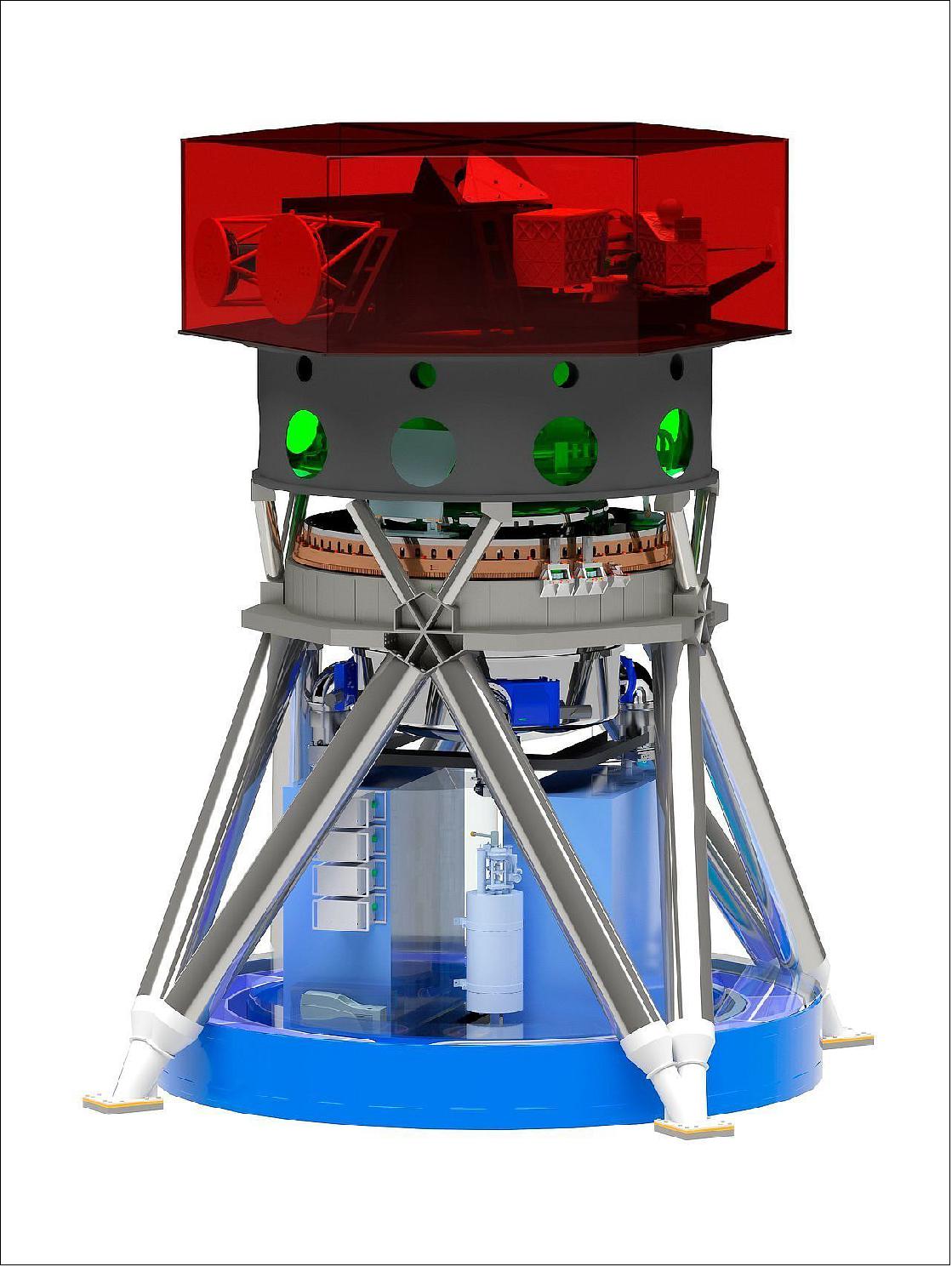
MAORY (Multi-conjugate Adaptive Optics RelaY)
As a first-generation ELT instrument, MAORY will help compensate for the distortion of light caused by turbulence in the Earth's atmosphere which makes astronomical images blurry. MAORY will not make observations itself; rather, it will enable other instruments, such as MICADO in the first instance, to take exceptional images. 20)
Science with MAORY: MAORY is a multi-conjugate adaptive optics system: it will not make scientific observations by itself, but will instead enable other instruments to make observations with excellent image quality.
In combination with MICADO, and making full use of the increased light-gathering power of the ELT, MAORY will help astronomers to observe distant galaxies at approximately redshifts 2-3 in unprecedented detail. This is an important epoch in the history of the Universe as we are looking at the light from galaxies at the time when astronomers believe that most galaxies formed. Additionally, by taking spatially resolved images with ELT, the individual sites of star formation in the galaxies can be measured and their physical characteristics determined.
MAORY will also enable MICADO to get a closer look at the massive black hole at the center of the Milky Way than ever before. The black hole affects the orbits of nearby stars; using previous instruments, astronomers have mapped the motions of these stars down to a distance of 25 light days from the black hole, but the MAORY/MICADO duo will get to a distance of just five light-days.
Instrument Consortium: The MAORY project is managed, together with ESO, by an international consortium composed of three research institutes: the Grenoble Institute for Planetary Sciences and Astrophysics (IPAG), France, the National Institute of Astrophysics (INAF), Italy, and the University of Galway, Ireland.
Instrument design: MAORY will use nine guide stars (three real stars and six artificial laser stars), state-of-the-art wavefront sensors, and up to three deformable mirrors to measure and correct for turbulence at three different heights in the atmosphere.
To measure atmospheric turbulence, MAORY will observe three natural guide stars around the scientific field-of-view of the camera (MICADO) but it will also use the ELT's laser guide stars to reach the demanding image quality required for MICADO's ambitious science goals. The distortion of light by atmospheric turbulence will be measured by wavefront sensors using newly developed detectors capable of reading images hundreds of times per second with low noise.
MAORY uses six large mirrors to deliver light from the focal plane of the telescope to the focal plane of MICADO. By tilting one of those mirrors, it is possible to steer the light beam towards MICADO or the second client instrument. The wavefront sensors for the natural guide stars are physically attached to MICADO to maximize the scientific performance. A dichroic beam splitter in the optical path separates the short wavelength (laser) light into the laser guide star module from the infrared light to the science instruments, and the natural guide star wavefront sensor cameras.
Multi-conjugate AO (Adaptive Optics) system | Six laser guide stars and three natural guide stars |
Up to two deformable mirrors | in addition to ELT M4 to correct atmospheric turbulence |
Two ports for instruments | MICADO and a future spectrograph |
SCAO (Single-conjugate AO) | as joint development between MAORY and MICADO |
Performance requirements | 50% Strehl ratio at 2.2 µm in the best conditions |
Sky coverage | 50% at the South Galactic Pole |
METIS (Mid-Infrared ELT Imager and Spectrograph)
METIS will be the third instrument on the Extremely Large Telescope (ELT). It will make full use of the giant, 39-meter main mirror of the telescope and focus on five scientific goals: exoplanets, proto-planetary disks, Solar System bodies, active galactic nuclei, and high-redshift infrared galaxies. 21)
The METIS powerful spectrograph will allow astronomers to investigate the basic physical and chemical properties of exoplanets, like their orbital parameters and structures, temperature, composition of their atmospheres, weather, seasons, etc. Only the innovation of the astronomers at the instrument's helm place limits on its use.
In addition, METIS will contribute to numerous other areas, including the study of the Martian atmosphere, properties of low-mass brown dwarfs, the center of the Milky Way, the environment of evolved stars, and gamma-ray bursts as cosmological probes. METIS will also have wide applications working at longer wavelengths and many ways of collaborating with other facilities, such as the future JWST (James Webb Space Telescope).

In Greek mythology, Metis was the spouse of Zeus and mother of Athena, goddess of wisdom. METIS is also the planned mid-infrared imager and spectrograph for the Extremely Large Telescope (ELT), Europe's next-generation ground-based telescope for optical and infrared (IR) wavelengths. Covering the L, M and N bands, METIS will offer imaging, coronagraphy and medium-resolution spectroscopy over the full wavelength range (3-13 µm), and high-resolution integral field spectroscopy in L and M bands (3-5 µm). 22)
METIS is a collaboration of nine European astronomy organisations, each represented by one co-Investigator: 23)
• NOVA, Dutch research school for astronomy (Leiden, Amsterdam, Groningen, Nijmegen): Bernhard Brandl (PI, Leiden University)
• UK Astronomy Technology Centre in Edinburgh, UK: Alistair Glasse
• MPIA (Max Planck Institute for Astronomy) in Heidelberg, Germany: Markus Feldt
• Katholieke Universiteit Leuven, Belgium: Hans van Winckel
• CEA-Saclay, France: Eric Pantin
• ETH Zürich, Switzerland: Sascha Quanz
• A* (Wien, Linz-RICAM, Uni Linz, Innsbruck, Graz), Austria: Manuel Guedel (Wien)
• Universität zu Köln, Germany: Lucas Labadie
• multidisciplinary centre for astrophysics (centra), Lisbon, Portugal: Paulo Garcia
• University of Liège, Belgium: Olivier Absil
• ASIAA, Taiwan: Paul Ho
• University of Michigan, USA: Michael Meyer
Development Status
• 05 June 2020: METIS, the powerful imager and spectrograph for ESO's Extremely Large Telescope (ELT), has passed its Preliminary Design Review at ESO's headquarters in Garching, Germany. METIS (Mid-infrared ELT Imager and Spectrograph) will make full use of the giant main mirror of the telescope to study a wide range of science topics, from objects in our Solar System to distant active galaxies. METIS will be extremely well suited to study the life cycle of stars, from infant stars and planet-forming discs to older stars near the end of their lifetime. 24)
- The ELT will be the largest optical to mid-infrared telescope on Earth when it starts operations towards the middle of this decade. With its 39-meter primary mirror and advanced adaptive-optics systems, it will have six times the resolution of the James Webb Space Telescope. METIS will take full advantage of this remarkable telescope and its adaptive optics to probe the structure and composition of objects with revolutionary precision.
- Now that the instrument has passed this Preliminary Design Review, the METIS consortium will continue to develop its design in further detail before construction on the instrument starts.
HIRES (HIgh REsolution Spectrograph)
The high-resolution ELT instrument HIRES will allow astronomers to study astronomical objects that require highly sensitive observations. It will be used to search for signs of life in Earth-like exoplanets, find the first stars born in the Universe, test for possible variations of the fundamental constants of physics, and measure the acceleration of the Universe's expansion. 25)
Science with HIRES: HIRES has a broad range of science cases. Some of its most outstanding scientific goals include characterizing the atmosphere of Earth-like exoplanets—with the ultimate goal of detecting signatures of life—identifying the very first generation of stars, studying possible variations in some of the fundamental constants of physics, and directly measuring the acceleration of the Universe's expansion. 26)
Thanks to the ELT's enormous main mirror, HIRES will be able to explore and characterize planets outside of our Solar System. After decades of detecting exoplanets, the focus is now on observing and quantifying their atmospheres; the ultimate goal is to detect signatures of life. The unprecedented capabilities of HIRES will enable astronomers to investigate the chemical composition, layers, and weather in the atmospheres of many different types of exoplanets, from Neptune-like to Earth-like, including those in stars' habitable zones. HIRES will also be able to observe forming protoplanets and their impact on the natal protoplanetary disc.
Moving much further from Earth, HIRES is likely to be the first instrument to unambiguously detect the fingerprints of the first generation of stars ("population III" stars) that lit up the primordial Universe. This will be achieved by measuring the relative abundance of various chemical elements in the intergalactic medium in the early Universe and by detecting the chemical enrichment pattern typical of the first supernova explosions.
Beyond astronomy, HIRES will reach into the territory of fundamental physics. It will help astronomers determine whether some of the fundamental constants of physics, which regulate most physical processes in the Universe, could actually change with time or space. In particular, HIRES will provide the most accurate tests of the fine-structure constant and the electron-to-proton mass ratio. Furthermore, HIRES will be used to directly measure the acceleration of the Universe's expansion; such a measurement would greatly impact our understanding of the Universe and its fate.
Instrument Consortium: The HIRES project is developed by an International Consortium composed by Research Institutes of 14 Countries. Brazil: Nucleo de Astronomia Observacional, Universidade Federal do Rio Grande do Norte (CI); Instituto Maua de Tecnologia. Canada: Institut de Recherche sur les Exoplanètes and Observatoire du Mont-Mégantic, département de physique, Université de Montréal. Chile: Pontificia Universidad Catolica de Chile (CI); Centre of Astro Engineering, Universidad de Chile; Department of Astronomy, Universidad de Concepcion; Center of Astronomical Instrumentation, Universidad de Antofagasta. Denmark: Niels Bohr Institute, University of Copenhagen (CI); Department of Physics and Astronomy, Aarhus University. France: Laboratoire d'Astrophysique de Marseille, CNRS, CNES, AMU (CI); Institut de Planétologie et d'Astrophysique de Grenoble, Université Grenoble Alpes; Laboratoire Lagrange, Observatoire de la Cote d'Azur; Observatoire de Haute Provence, CNRS, AMU, Institut Pythéas, Institut de Recherche en Astrophysique et Planetologie, Observatoire Midi-Pyrénées; Laboratoire Univers et Particules, Université de Montpellier. Germany: Leibniz-Institut für Astrophysik Potsdam (CI); Institut für Astrophysik, Universität Göttingen; Zentrum für Astronomie Heidelberg, Landessternwarte; Thüringer Landesternwarte Tautenburg; Hamburger Sternwarte, Universität Hamburg. Italy: INAF, Istituto Nazionale di Astrofisica (Lead Technical Institute). Poland: Faculty of Physics, Astronomy and Applied Informatics, Nicolaus Copernicus University in Torun. Portugal: Instituto de Astrofisica e Cieências do Espaco (IA) at Centro de Investigaco em Astronomia/Astrofisica da Universidade do Porto (CI), Instituto de Astrofisica e Ciencias do Espaco at Faculdade de Ciências da Universidade de Lisa. Spain: Instituto de Astrofisica de Canarias (CI); Instituto de Astrofisica de Andalucia-CSIC; Centro de Astrobiologia. Sweden: Dept. of Physics and Astronomy, Uppsala University. Switzerland: Département d'Astronomie, Observatoire de Sauverny, Université de Genêve (CI); Universität Bern, Physikalische Institut. United Kingdom: Science and Technology Facilities Council (CI); Cavendish Laboratory & Institute of Astronomy, University of Cambridge; UK Astronomy Technology Centre; Institute of Photonics and Quantum Sciences, Heriot-Watt University. USA: Department of Astronomy, University of Michigan.
Instrument Design: The HIRES baseline design is that of a modular fibre-fed cross dispersed echelle spectrograph which has two ultra-stable spectral arms, visual and near-infrared, providing a simultaneous spectral range of 0.4 -1.8 µm at a spectral resolving power of R~100,000 for a single object. HIRES will also include an IFU mode fed by a single-conjugate adaptive optics (SCAO) module to correct for the blurring effect of turbulence in the atmosphere.
HIRES will separate light from the ELT mirrors into two-wavelength channels using dichroic filters. Each wavelength channel interfaces with several fibre bundles that feed the corresponding spectrograph module (visual and near-infrared). Each fibre-bundle corresponds to an observing mode. All spectrometer modules have a fixed configuration, i.e. no moving parts. They include a series of parallel entrance slits consisting of linear micro-lense arrays each glued to the fibre bundles.
HIRES has completed the initial project stage known as Phase A.
Wavelength | 0.55—1.80 µm (baseline), 0.33—2.44 µm (goal) |
Spectral Resolution | 100,000 - 150,000 |
FOV | 0.170'', 64 fibres (R ~ 100,000), 0.113'', 96 fibres (R ~ 150,000) |
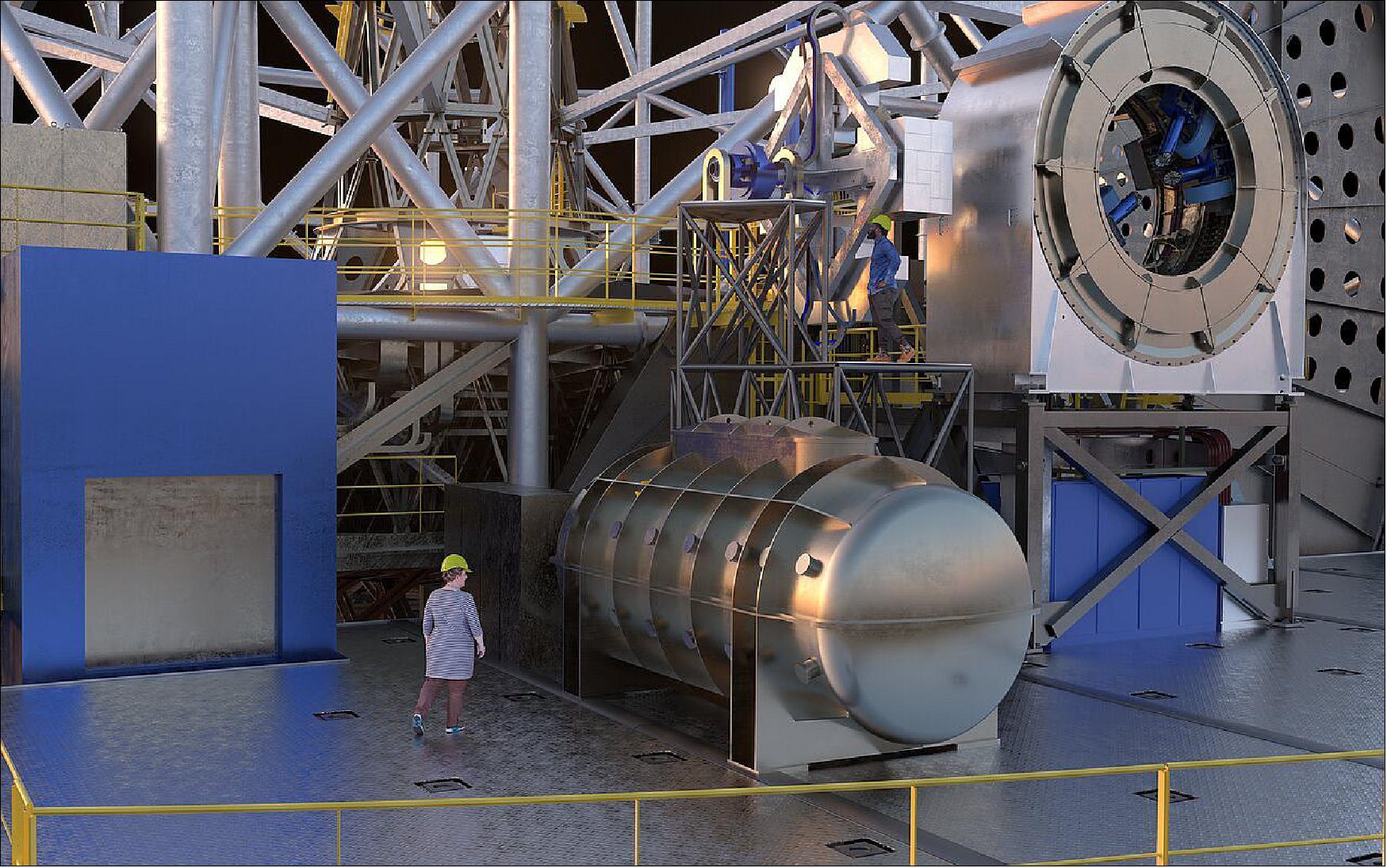
MOSAIC (Multi-Object Spectrograph)
By peering at objects from stars at the heart of the Milky Way to the most distant galaxies at the very edge of the observable Universe, MOSAIC will enable astronomers to trace the growth of galaxies and the distribution of matter from the Big Bang to the present day. 27)
Astronomers face a major challenge: the Universe contains hundreds of billions of galaxies, each of which contains hundreds of billions of stars. Surveying all of these and unravelling the mysteries behind the evolution of the Universe calls for a multi-object spectrograph that can measure the light from many different objects at the same time. MOSAIC is being built to do just this, as well as to serve as a follow-up machine of future space-based missions, such as the James Webb Space Telescope, as well as the European Space Agency's Euclid, and Athena missions.
Instrument design: To satisfy MOSAIC's science cases and requirements, the Phase A design includes three observation modes: 28)
• High multiplex mode in the visible (HMM-VIS): Simultaneous integrated-light observations of almost 200 objects, with the possibility of using both medium and high spectral resolving power (R~5000 and R~20,000).
• High multiplex mode in the near-infrared (HMM-NIR): Simultaneous integrated-light observations of 80 objects (goal: 100) each of them with dedicated sky fibres to subtract the strong sky background present in the near-infrared. This mode will cover simultaneously the wavelength range 0.8–1.8 µm with the possibility to observe in medium and high spectral resolving power.
• High-definition mode (HDM): Simultaneous observations of eight integral field units (IFUs) (goal: 10 IFUs) deployed within a ~40 arcmin patrol field. Each IFU will cover a 2.5 arcsec hexagon with ~200 milliarcseconds spaxels, sharing the same spectrograph as for the HMM-NIR, with same wavelength coverage and spectral resolving power.
MOSAIC has just completed the initial project stage known as Phase A.
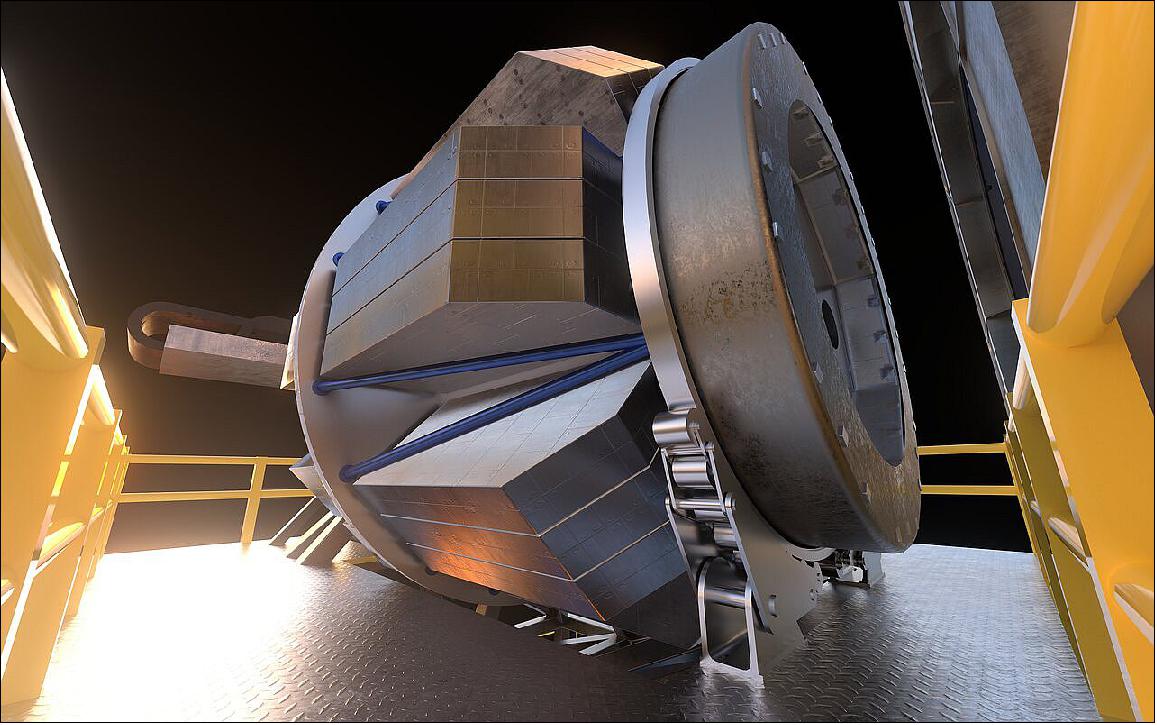
Wavelength | 0.47 - 1.80 µm (baseline) |
Spectral resolution | 5,000 - 20,000 |
FOV (Field of View) | 40 square arcmin |
High Multiplex Mode | 200 in VIS and 80+80 in NIR (baseline) |
High Definition Mode | 8 (baseline) |
MOSAIC Consortium: The MOSAIC project is managed by an international consortium composed of research institutes from European and overseas countries. — MOSAIC is being designed and built under the leadership of the National Institute for Earth Sciences and Astronomy at the National Centre for Scientific Research (CNRS-INSU, France) by a consortium of partners in France, the United Kingdom, the Netherlands, Brazil, Germany, Austria, Finland, Italy, Portugal, Spain, Sweden, Switzerland. In addition to CNRS-INSU, the MOSAIC consortium consists of Durham University (United Kingdom), the Galaxies, Stars, Physics and Instrumentation Department at Paris Observatory (France), the Institute for Research in Astrophysics and Planetology at the University of Toulouse (France), the Marseille Astrophysics Laboratory (France), the National Physics Laboratory (Brazil), the Leibniz Institute for Astrophysics Potsdam (Germany), the LESIA Space and Astrophysics Instrumentation Research Laboratory at Paris Observatory (France), the Netherlands Research School for Astronomy (Netherlands), the University of São Paulo (Brazil), the University of Amsterdam (Netherlands), the University of Oxford / RAL Space (United Kingdom), the UK Astronomy Technology Centre (United Kingdom), University of Helsinki (Finland), the University of Michigan (US), Stockholm University (Sweden), LSW Heidelberg (Germany), the University of Geneva (Switzerland), the University of Vienna (Austria), IACE – Universidade de Lisboa (Portugal), Space Telescope Science Institute (US), Universidad Complutense de Madrid (Spain), INAF Roma (Italy). ESO also contributes to the project development.
Development Status
• February 12, 2021: The powerful combination of the cutting-edge multi-object spectrograph MOSAIC with the world largest telescope, the ELT, will allow us to probe deeper into the Universe than was possible. MOSAIC is an extremely efficient instrument in providing spectra for the numerous faint sources in the Universe, including the very first galaxies and sources of cosmic re-ionization. MOSAIC has a high multiplex in the NIR and in the VIS, in addition to multi-Integral Field Units (Multi-IFUs) in NIR. As such it is perfectly suited to carry out an inventory of dark matter (from rotation curves) and baryons in the cool-warm gas phases in galactic haloes at z=3-4. MOSAIC will enable detailed maps of the intergalactic medium at z=3, the evolutionary history of dwarf galaxies during a Hubble time, the chemistry directly measured from stars up to several Mpc (Mega parsec). Finally, it will measure all faint features seen in cluster gravitational lenses or in streams surrounding nearby galactic halos, providing MOSAIC to be a powerful instrument with an extremely large space of discoveries. The preliminary design of MOSAIC is expected to begin next year, and its level of readiness is already high, given the instrumental studies made by the team. 30)
• July 9, 2018: When combined with the huge collecting area of the ELT, MOSAIC will be the most effective and flexible Multi-Object Spectrograph (MOS) facility in the world, having both a high multiplex and a multi-Integral Field Unit (Multi-IFU) capability. It will be the fastest way to spectroscopically follow-up the faintest sources, probing the re-ionization epoch, as well as evaluating the evolution of the dwarf mass function over most of the age of the Universe. MOSAIC will be world-leading in generating an inventory of both the dark matter (from realistic rotation curves with MOAO fed NIR IFUs) and the cool to warm-hot gas phases in z=3.5 galactic haloes (with visible wavelength IFUs). Galactic archaeology and the first massive black holes are additional targets for which MOSAIC will also be revolutionary. MOAO and accurate sky subtraction with fibres have now been demonstrated on sky, removing all low Technical Readiness Level (TRL) items from the instrument. A prompt implementation of MOSAIC is feasible, and indeed could increase the robustness and reduce risk on the ELT, since it does not require diffraction limited adaptive optics performance. Science programs and survey strategies are currently being investigated by the Consortium, which is also hoping to welcome a few new partners in the next two years. 31)
- During the Phase A study, we performed early trade-offs which were applied to the so-called ‘full' MOSAIC option (itself already a compromise between cost and capability), which must be sufficiently versatile to address the community identified scientific priorities. The full MOSAIC includes high multiplex modes (HMM) in the visible and NIR, high definition IFUs in the NIR (HDM), and telescope PSF limited IFUs in the visible (IGM renamed VIFU) modes. The primary design goals are then:
a) To keep the system manageable. (For example, given the large spectral coverage, the different modes, and the foreseen multiplex, we require a carefully designed system to link the focal plane and the spectrograph);
b) To ensure the instrument is competitive in terms of throughput and survey efficiency.
- The latter has led us to limit the wavelength range to 450-1800 nm, because of the expected performance of the ELT mirror coatings in the far blue, and the expectedly strong background from the 5-mirror telescope in the K band, respectively. In the full MOSAIC option with 5 NIR and 5 VIS spectrographs, the multiplex is 200 in the visible, 100 in the NIR (with paired fibres for precision sky-subtraction purposes) and, finally, a multiplex of 10 for the HDM IFUs.
Phase A Design
- To satisfy the assembled science cases and requirements, the Phase A design includes four observational modes:
- High-definition mode (HDM): Simultaneous observations of 8 IFUs (goal: 10 IFUs) deployed within a ~40 arcmin2 patrol field and each with enhanced image quality from multi-object adaptive optics. Each IFU will cover a 1.9 arcsec hexagon with 80 mas spaxels, with the spectrographs delivering R~5000 over 0.8-1.8 µm (between 250 and 430 nm in one observation). A high spectral-resolution set-up will provide R~20,000 over a passband of ~100 nm at ~1.6 µm. The light entering each spaxel will be injected into a fibre that will be imaged onto 3.06 pixels on the detector.
- Visible Integral Field Unit mode (VIFU): Simultaneous observations of 8 IFUs (goal: 10 IFUs) deployed within a ~40 arcmin2 patrol field with telescope delivered ‘seeing-limited' performance (or GLAO-corrected, using M4 of the telescope). Each IFU will cover a 2.3 arcsec hexagon with 138 mas spaxels, with the spectrographs delivering R~5000 over 0.45-0.92 µm (between 150 and 230 nm in one observation). A possible high spectral-resolution set-up with R~15,000 could allow coverage of a passband of ~60 nm around 0.65 µm and/or 0.86 µm. The light entering each spaxel will be injected into a fibre that will be imaged onto 4.21 pixels on the detector.
- High multiplex mode in the near-IR (HMM-NIR): Simultaneous integrated-light observations of 80 objects (goal: 100) with dedicated sky fibres operated in cross-beam switching sequences. Each object will be observed with a bundle of 19 x 100 mas fibres, giving an on-sky aperture of 500 mas in diameter. Each fibre will be imaged onto 3.06 pixels on the detector. The spectrograph setups are identical to the HDM mode.
- High multiplex mode in the visible (HMM-VIS): Simultaneous integrated-light observations of 160 objects (goal: 200). Note that there will be no dedicated sky fibres in this mode, as the sky background is much fainter than in the near-IR. Each object will be observed with a bundle of 19 x 168 mas fibres, giving an on-sky aperture of 840 mas in diameter. Each fibre will be imaged onto 4.21 pixels on the detector. The spectrograph setups are identical to the VIFU mode.
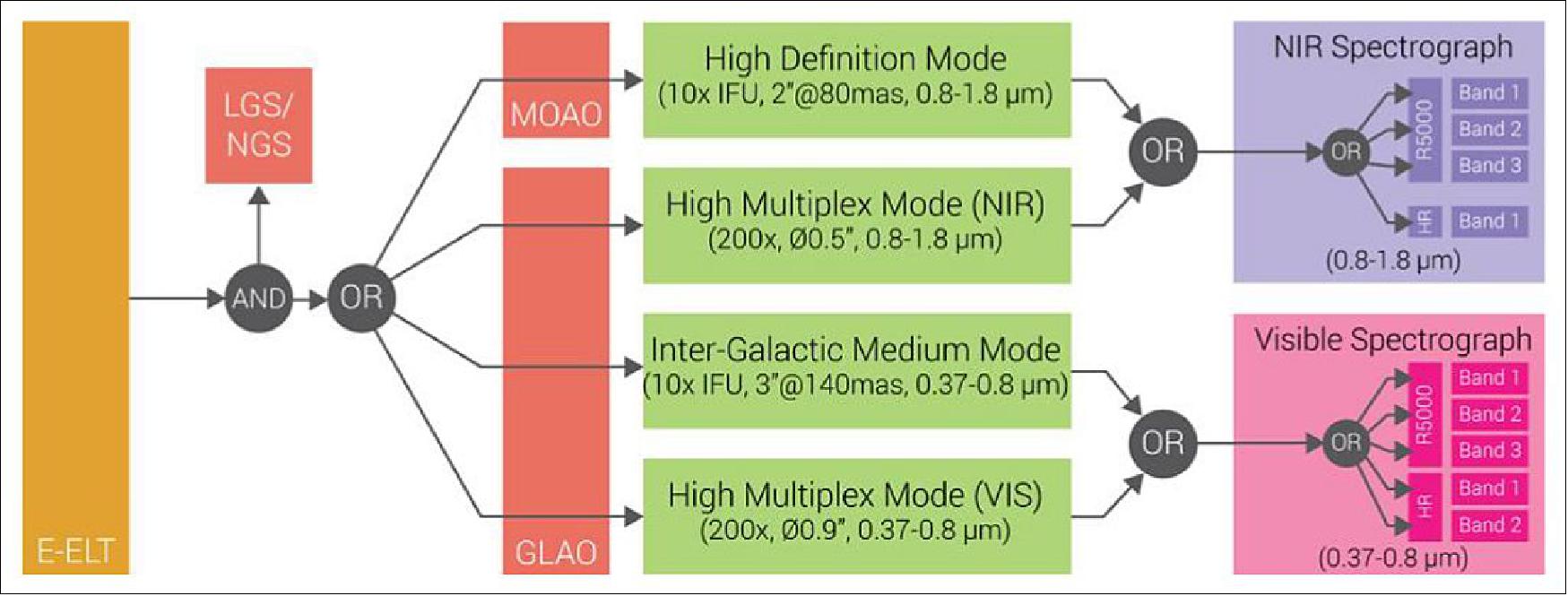
- MOSAIC has been designed to be highly modular, allowing for potential descopes and phased deployment. Figure 27 illustrates this.
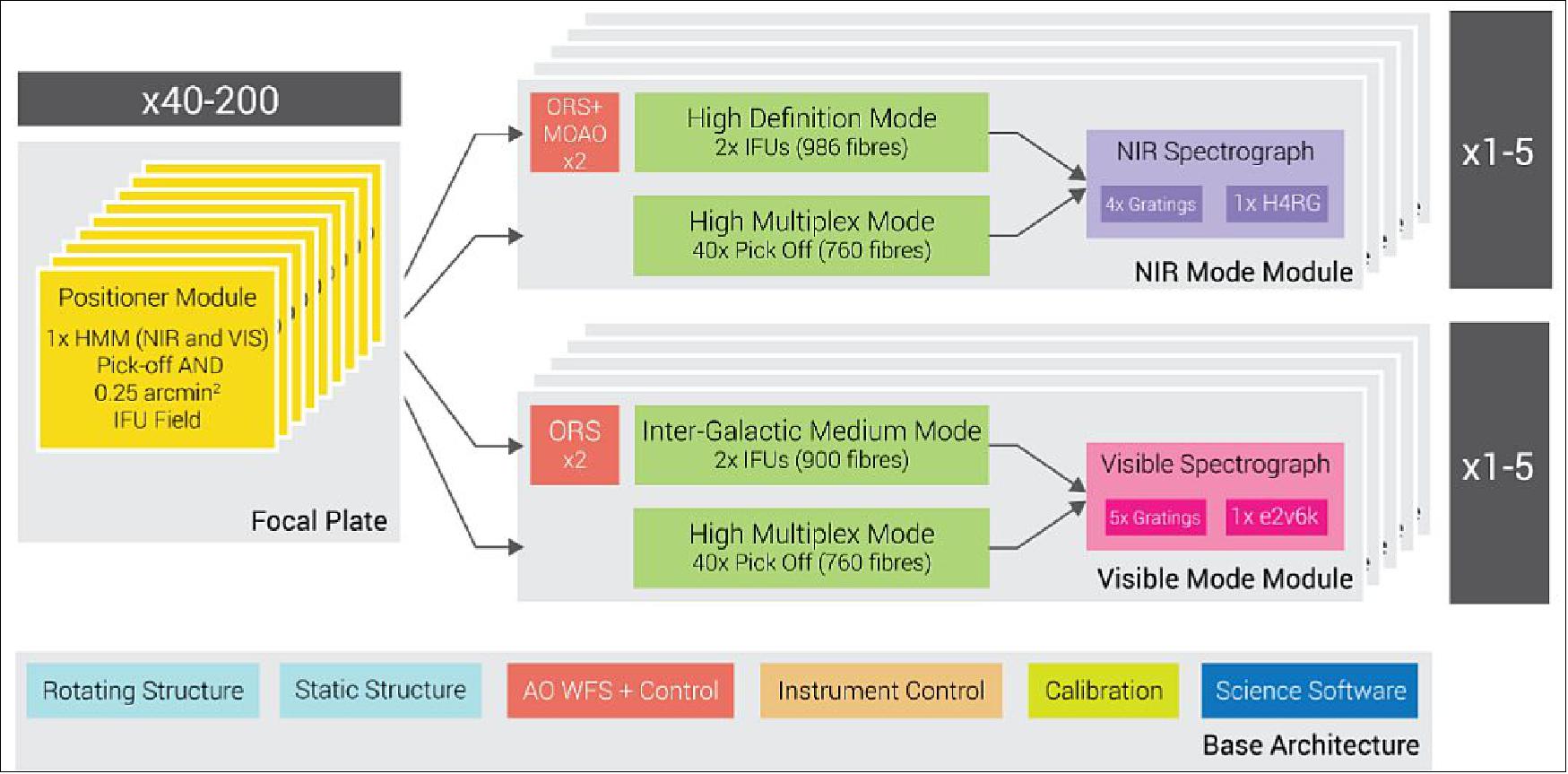
- As the focal plane of the instrument will be rotating around the telescope azimuth axis, the gravitational loads on the instrument core depend on the orientation of the instrument. The rotating structure will therefore be subjected to significant non-axial loads, inducing substantial out-of-plane bending moments. In order to achieve an acceptable resistance to the gravity-induced deformations, the design shown in the Figure 28 has been adopted.
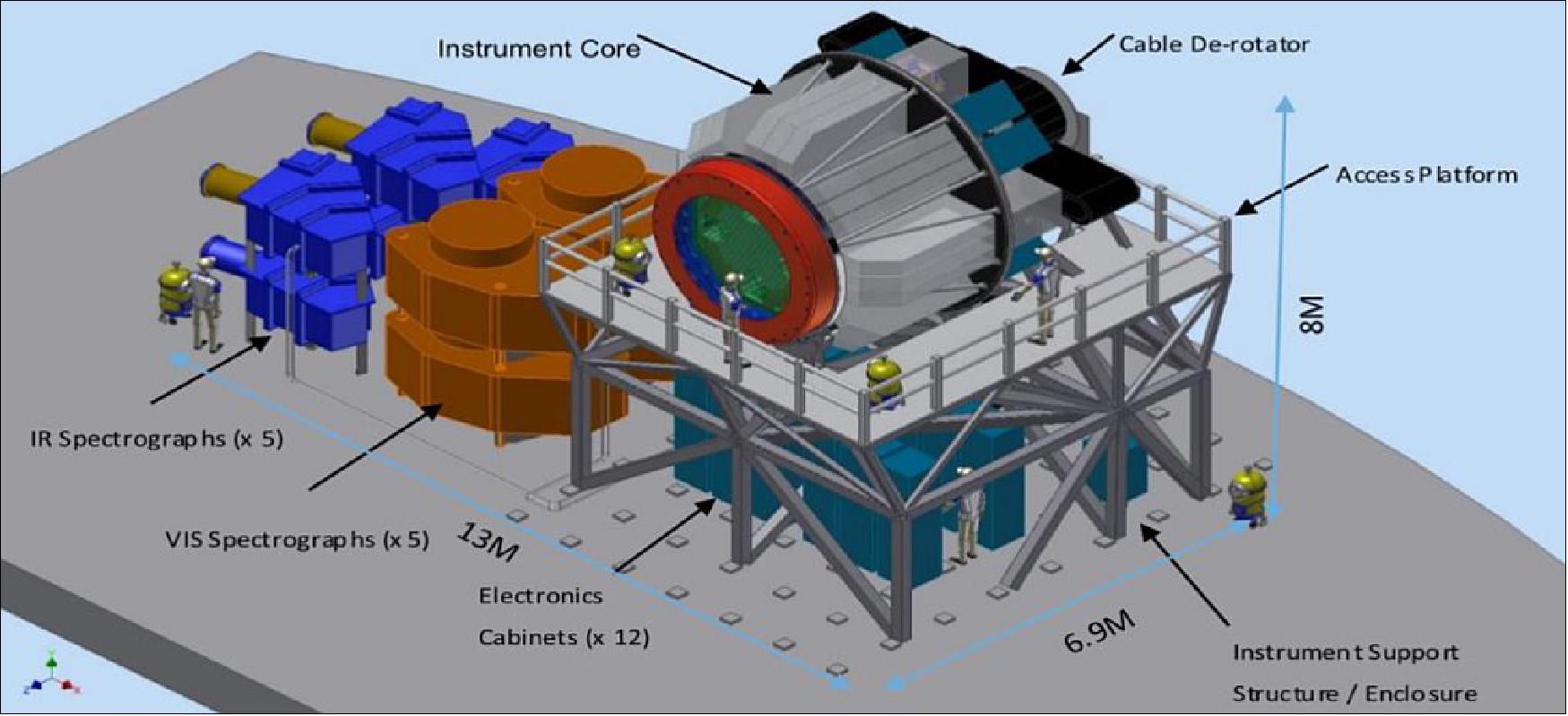
• 2016: The Multi-Object Spectrograph, also known as MOSAIC, is a proposed instrument for ESO's forthcoming Extremely Large Telescope (ELT). MOSAIC is currently in the initial project stage known as Phase A. The study contract was signed at the Paris Observatory on 18 March 2016 by ESO and the CNRS–INSU, the leading technical institute in the MOSAIC consortium. The consortium includes institutions from five countries (France, United Kingdom, The Netherlands, Brazil and Germany) with six associated partners (Austria, Finland, Italy, Portugal, Spain and Sweden). 32)
MOSAIC will provide the ELT with the powerful ability to obtain visible and near-infrared spectroscopy of large samples of astronomical objects, improving upon ESO's current facilities. It will provide unprecedented observations of objects ranging from stars at the very heart of the Milky Way to the most distant galaxies at the edge of the observable Universe. These future observations will allow astronomers to trace the growth of galaxies and the distribution of matter from shortly after the Big Bang to the present day. 33)
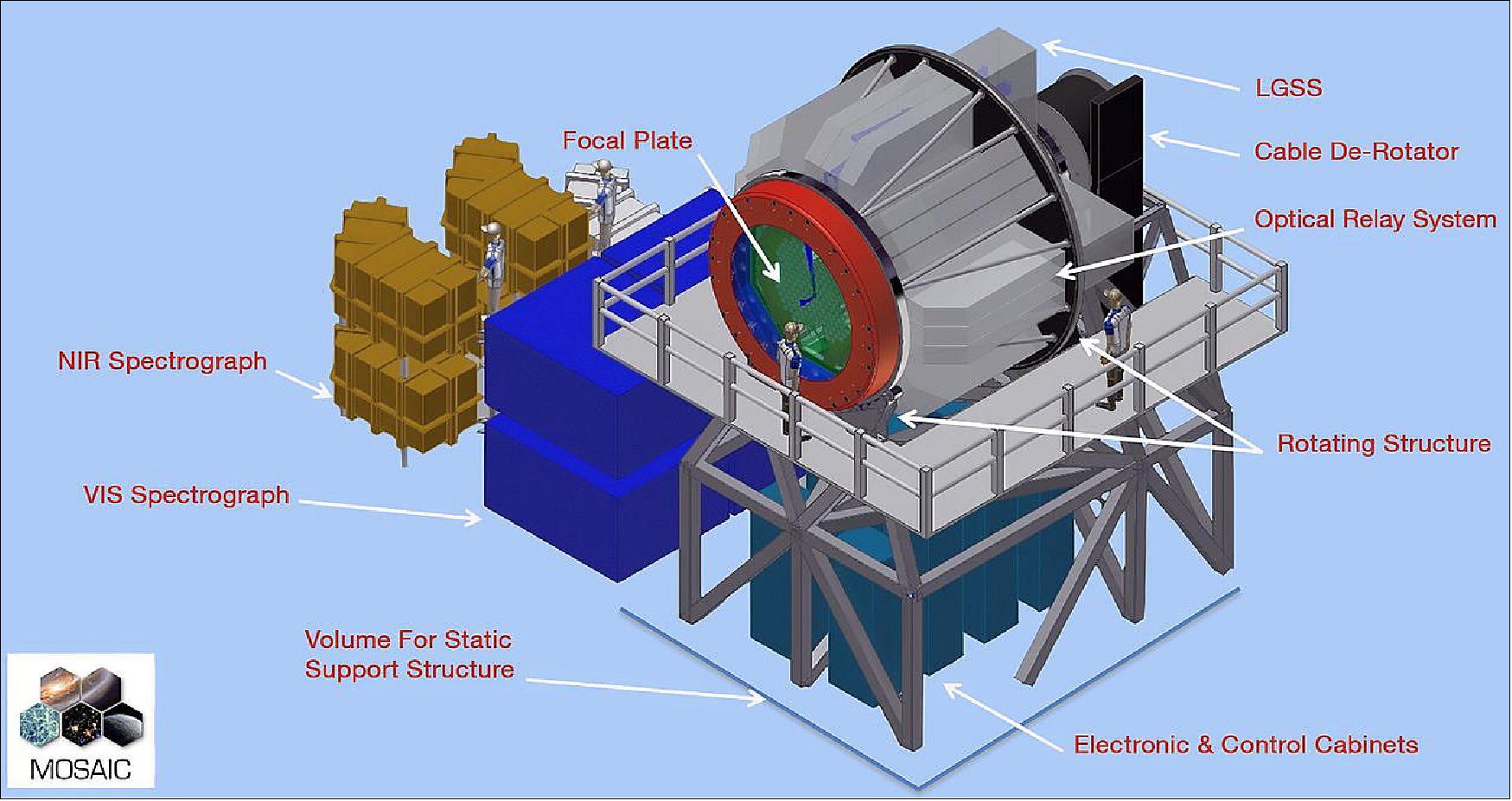
The workhorse instruments of the current 8-10 m class observatories are multi-object spectrographs (MOS), providing comprehensive follow-up of ground-based and space-borne imaging data. With the advent of even deeper imaging surveys from, e.g., HST, VISTA, JWST and Euclid, many science cases require complementary spectroscopy with high sensitivity and good spatial resolution to identify the objects and to measure their astrophysical parameters. The light-gathering power of the 39 m ELT and its spatial resolution, combined with a MOS, will enable the large samples necessary to tackle some of the key scientific drivers of the ELT project, ranging from studies of stellar populations out to the highest-redshift galaxies. Consequently, a MOS-facility is foreseen within the ELT instrumentation plan. 34)
Consortium: The MOSAIC project brings together the design and analysis work done on all previous conceptual designs for a MOS for the ELT. The MOSAIC Consortium includes world-leaders in the design, development, and construction of astronomical instrumentation, located across Europe and Brazil, and supported as high priority by their funding agencies. Partners within the MOSAIC consortium have a long and successful heritage of instrument delivery for ESO, including: FLAMES, KMOS, MUSE, SPHERE, NACO, VIMOS, and X-SHOOTER. This makes available the skills needed to develop MOSAIC whatever the area: Adaptive Optics, Fibres, Spectrograph, Interfaces with the telescope, etc. The MOSAIC instrument concept is now under development and will provide a versatile, facility-class instrument, capable of addressing a broad range of key science topics enabled by the size and adaptive optics of the ELT.
The Consortium includes countries in the core of the project (Partners : France, United Kingdom, The Netherlands, Brazil, Germany) as well as other participating countries (Associate Partners : Austria, Finland, Italy, Portugal, Spain, Sweden, Switzerland) including those interested in financially supporting the project in exchange of Guaranteed Observing Time or in participation in Public Surveys.
The Lead Technical Institute (LTI) will be Institut National des Sciences de l'Univers du Centre National de la Recherche Scientifique acting on behalf of its laboratories: GEPI (CNRS, Observatoire de Paris, Univ. Paris-Diderot), LESIA (CNRS, Observatoire de Paris, Univ. Paris-Diderot, Univ. Pierre et Marie Curie), LAM (CNRS, Univ. Marseille) and IRAP (CNRS, Univ. Toulouse). The PI (F. Hammer), the PM (P. Jagourel) as well as key science and technical responsibilities (Co PS, dep. PM, dep. IS, dep. PM, dep. SE in charge of end-to-end optical design, PAM, IT, administrative support) will all be gathered within the Project Office hosted at the Observatoire de Paris (OP). OP will also lead key WPs such as AO implementation, fibre system design and DRS. The AIT will be performed at the LAM site of the LTI. A full support for this phase A will be organized by INSU/CNRS. The LTI has proven its record in managing, constructing and delivering of major astronomical instruments.
• March 31, 2015: This White Paper presents the scientific motivations for a multi-object spectrograph (MOS) on the European Extremely Large Telescope (E-ELT). The MOS case draws on all fields of contemporary astronomy, from extra-solar planets, to the study of the halo of the Milky Way and its satellites, and from resolved stellar populations in nearby galaxies out to observations of the earliest 'first-light' structures in the partially-reionised Universe. The material presented here results from thorough discussions within the community over the past four years, building on the past competitive studies to agree a common strategy toward realising a MOS capability on the E-ELT. The cases have been distilled to a set of common requirements which will be used to define the MOSAIC instrument, entailing two observational modes ('high multiplex' and 'high definition'). When combined with the unprecedented sensitivity of the E-ELT, MOSAIC will be the world's leading MOS facility. In analysing the requirements we also identify a high-multiplex MOS for the longer-term plans for the E-ELT, with an even greater multiplex (>1000 targets) to enable studies of large-scale structures in the high-redshift Universe. Following the green light for the construction of the E-ELT the MOS community, structured through the MOSAIC consortium, is eager to realise a MOS on the E-ELT as soon as possible. We argue that several of the most compelling cases for ELT science, in highly competitive areas of modern astronomy, demand such a capability. For example, MOS observations in the early stages of E-ELT operations will be essential for follow-up of sources identified by the James Webb Space Telescope (JWST). In particular, multi-object adaptive optics and accurate sky subtraction with fibres have both recently been demonstrated on sky, making fast-track development of MOSAIC feasible. 35)
References
1) "ESO's Extremely Large Telescope -The world's biggest eye on the sky," ESO, URL: https://www.eso.org/public/teles-instr/elt/
2) "E- ELT The European Extremely Large Telescope — The World's Biggest Eye on the Sky," E-ELT brochure, URL: https://www.eso.org/public/archives/brochures/pdfsm/brochure_0022.pdf
3) "Four Centuries of the Telescope — Four Centuries of Discovery," ESO, 2009, URL: https://www.eso.org/sci/facilities/eelt/science/doc/eelt_sciencecase.pdf
4) "ESOcast 84: The New E-ELT Design Unveiled," ESO, 25 May 2016, URL: https://www.eso.org/public/videos/eso1617a/
5) "Artist's rendering of the ELT in operation," ESA, 26 May 2017, URL: https://www.eso.org/public/images/eso1716a/
6) ESO's Extremely Large Telescope planned to start scientific operations in 2027," ESO ann21008-Announcement, 11 June 2021, URL: https://elt.eso.org/public/announcements/ann21008/
7) "Funding boost for ESO's Extremely Large Telescope," ESO ann20034 — Announcement, 4 December 2020, URL: https://www.eso.org/public/announcements/ann20034/?lang
8) "First 18 ELT Primary Mirror Blanks Arrive at Safran Reosc," ESO ann19040 — Announcement, 2 August 2019, URL: https://www.eso.org/public/announcements/ann19040/?lang
9) "Extremely large astronomy," ESO, potw1844a, 29 October 2018, URL: https://www.eso.org/public/images/potw1844a/
10) "First ELT Main Mirror Segments Successfully Cast," eso1801 — Organization Release, 9 January 2018, URL: https://www.eso.org/public/news/eso1801/
11) "Renaming the E-ELT," Statement from ESO's Director General, ESO, ann17031, 12 June 2017, URL: https://www.eso.org/public/announcements/ann17031/
12) "The optical system of the ELT showing the location of the mirrors," eso1704a, 18 January 2017, URL: https://www.eso.org/public/images/eso1704a/
13) "E-ELT Site Chosen -World's Biggest Eye on the Sky to be Located on Armazones, Chile," eso1018 Release, 26 April 2010, URL: https://www.eso.org/public/news/eso1018/
14) HARMONI (High Angular Resolution Monolithic Optical and Near-infrared Integral field spectrograph)," ESO, URL: https://elt.eso.org/instrument/HARMONI/#design
15) MICADO (Multi-AO Imaging Camera for Deep Observations), ESO, URL: https://elt.eso.org/instrument/MICADO/#science
16) "Instrument Design," ESO, URL: https://elt.eso.org/instrument/MICADO/#design
17) "MICADO – the 1st Light Camera for deep observations with the 39-m 'Extremely Large Telescope' (ELT) of ESO," University of Göttingen, URL: https://www.uni-goettingen.de/en/
micado+%e2%80%93+the+1st+light+camera+for+deep+observations+with+the+39
-m+%27extremely+large+telescope%27+%28elt%29+of+eso+/263488.html
18) "ELT MICADO instrument successfully completes preliminary design phase," MPIA, 21 January 2020, URL: https://www.mpia.de/4919483/2019-08-01-elt-micado-pdr-en
19) "ELT MICADO instrument successfully completes preliminary design phase," MPIA, 21 January 2020, URL: https://www.mpia.de/4919483/2019-08-01-elt-micado-pdr-en
20) MAORY (Multi-conjugate Adaptive Optics RelaY), ESO, URL: https://elt.eso.org/instrument/MAORY/
21) "METIS - The Mid-infrared ELT Imager and Spectrograph," ESO, URL: https://www.eso.org/public/teles-instr/elt/elt-instr/metis/
22) RL: METIS The Mid-Infrared ELT Imager and Spectrograph," https://metis.strw.leidenuniv.nl/
23) "The METIS consortium," https://metis.strw.leidenuniv.nl/about/
24) "METIS Instrument Passes Design Milestone," ESO, ann20016. 5 June 2020, URL: https://www.eso.org/public/announcements/ann20016/
25) HIRES (HIgh REsolution Spectrograph), ESO, URL: https://elt.eso.org/instrument/HIRES/
26) "Science with HIRES," ESA, URL: https://elt.eso.org/instrument/HIRES/#science
27) "MOSAIC (Multi-Object Spectrograph)," ESO, URL: https://elt.eso.org/instrument/MOSAIC/
28) Instrument Design," ESO, URL: https://elt.eso.org/instrument/MOSAIC/#design
29) "MOSAIC - A unique instrument for the biggest telescope," EU, URL: http://www.mosaic-elt.eu/index.php/science
30) F. Hammer, S. Morris, J. G. Cuby, L. Kaper, M. Steinmetz, J. Afonso, B. Barbuy, E. Bergin, A. Finogenov, J. Gallego, S. Kassin, C. Miller, G. Ostlin, L. Penterricci, D. Schaerer, B. Ziegler, F. Chemla, G. Dalton, F. De Frondat, C. Evans, D. Le Mignant, M. Puech, M. Rodrigues, R. Sanchez-Janssen, S. Taburet, L. Tasca, Y. B. Yang, S. Zanchetta, K. Dohlen, M. Dubbeldam, K. El Hadi, A. Janssen, A. Kelz, M. Larrieu, I. Lewis, M. MacIntosh, T. Morris, R. Navarro, W. Seifert, "MOSAIC on the ELT: high-multiplex spectroscopy to unravel the physics of stars and galaxies from the dark ages to the present-day," ESO Messenger No.182, ESO, March 2021, pp:33-37, URL: https://www.eso.org/sci/publications/
messenger/archive/no.182-mar21/messenger-no182-33-37.pdf
31) Simon Morris, François Hammer, Pascal Jagourel, Christopher J. Evans, Mathieu Puech, Gavin B. Dalton, Myriam Rodrigues, Ruben Sanchez-Janssen, Ewan Fitzsimons, Beatriz Barbuy, Jean-Gabriel Cuby, Lex Kaper, Martin Roth, Gérard Rousset, Richard Myers, Olivier Le Fèvre, Alexis Finogenov, Jari Kotilainen, Bruno Castilho, Goran Ostlin, Sofia Feltzing, Andreas Korn, Jesus Gallego, África Castillo Morales, Jorge Iglesias-Páramo, Laura Pentericci, Bodo Ziegler, Jose Afonso, Marc Dubbledam, Madeline Close, Phil Parr-Burman, Timothy J. Morris, Fanny Chemla, Fatima De Frondat, Andreas Kelz, Isabelle Guinouard, Ian J. Lewis, Kevin Middleton, Ramon Navarro, Marie LarrieuJohan Pragt, Annemieke Janssen, Kjetil Dohlen, Kacem El Hadi, Éric Gendron, Yanbin Yang, Martyn Wells, Jean-Marc Conan, Thierry Fusco, Daniel Schaerer, Ted Bergin, Sylvestre Taburet, Mickaël Frotin, Nadia Berkourn, "The ELT-MOS (MOSAIC): towards the construction phase," SPIE Proceedings, Volume 10702, 'Ground-based and Airborne Instrumentation for Astronomy VII;' Instrumentation and Methods for Astrophysics,' https://doi.org/10.1117/12.2311430, Event: SPIE Astronomical Telescopes + Instrumentation, 2018, Austin, Texas, United States, URL: https://arxiv.org/ftp/arxiv/papers/1807/1807.00720.pdf
32) "MOSAIC (Phase A completed)," ESO, URL: https://www.eso.org/public/teles-instr/elt/elt-instr/mosaic/
34) "MOSAIC -A unique instrument for the biggest telescope," URL: http://www.mosaic-elt.eu/
35) Chris Evans, Mathieu Puech, Jose Afonso, Omar Almaini, Philippe Amram, Hervé Aussel, Beatriz Barbuy, Alistair Basden, Nate Bastian, Giuseppina Battaglia, Beth Biller, Piercarlo Bonifacio, Nicholas Bouché, Andy Bunker, Elisabetta Caffau, Stephane Charlot, Michele Cirasuolo, Yann Clenet, Francoise Combes, Chris Conselice, Thierry Contini, Jean-Gabriel Cuby, Gavin Dalton, Ben Davies, Alex de Koter, Karen Disseau, Jim Dunlop, Benoît Epinat, Fabrizio Fiore, Sofia Feltzing, Annette Ferguson, Hector Flores, Adriano Fontana, Thierry Fusco, Dimitri Gadotti, Anna Gallazzi, Jesus Gallego, Emanuele Giallongo, Thiago Gonçalves, Damien Gratadour, Eike Guenther, Francois Hammer, Vanessa Hill, Marc Huertas-Company, Roridgo Ibata, Lex Kaper, Andreas Korn, Søren Larsen, Olivier Le Fèvre, Bertrand Lemasle, Claudia Maraston, Simona Mei, Yannick Mellier, Simon Morris, Göran Östlin, Thibaut Paumard, Roser Pello, Laura Pentericci, Celine Peroux, Patrick Petitjean, Myriam Rodrigues, Lucía Rodríguez-Muñoz, Daniel Rouan, Hugues Sana, Daniel Schaerer, Eduardo Telles, Scott Trager, Laurence Tresse, Niraj Welikala, Stefano Zibetti, Bodo Ziegler, "The Science Case for Multi-Object Spectroscopy on the European ELT," Astrophysics of Galaxies, 'Instrumentation and Methods for Astrophysics (astro-ph.IM); Solar and Stellar Astrophysics (astro-ph.SR),' Published: 31 March 2015, https://arxiv.org/abs/1501.04726v2, URL: https://arxiv.org/ftp/arxiv/papers/1501/1501.04726.pdf
The information compiled and edited in this article was provided by Herbert J. Kramer from his documentation of: "Observation of the Earth and Its Environment: Survey of Missions and Sensors" (Springer Verlag) as well as many other sources after the publication of the 4th edition in 2002. - Comments and corrections to this article are always welcome for further updates (eoportal@symbios.space).
European Extremely Large Telescope Development Status Sensor Complement References Back to top